Motorola Mobility T56HP1 Portable Cellular/ PCS GSM/ EDGE Transceiver w/ BT User Manual Z8 3G EMEA UG 09 03 07
Motorola Mobility LLC Portable Cellular/ PCS GSM/ EDGE Transceiver w/ BT Z8 3G EMEA UG 09 03 07
Exhibit 8 Users Manual
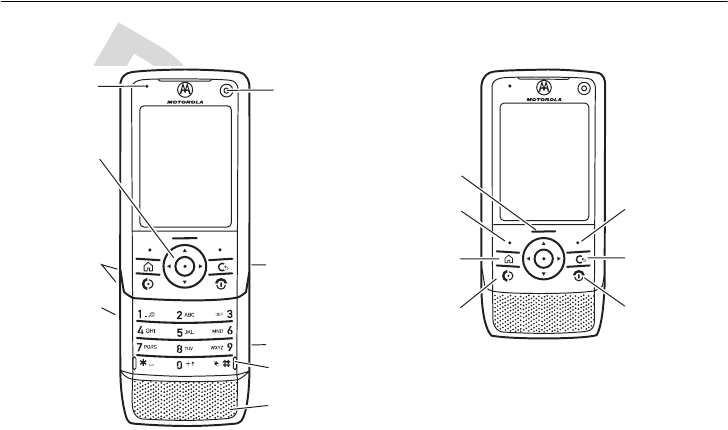
1
HELLOMOTO
Introducing your new
MOTO
RIZR™
Z8 3G wireless phone. Here’s a quick anatomy lesson.
Right Soft Key
Clear/Back Key
Scroll up,
down, left, right
or press centre
to select.
Left Soft Key
Home Key
Volume Keys
Make &
answer calls.
Video Call Key
Media Player
Key
Camera Key
Turn on & off,
hang up, exit
menus.
Secondary
Camera
Lens
Handsfree
Microphone
Call Key End Key
Navigation Key
Microphone
Bumper Bar
Battery Empty Charging Indicator
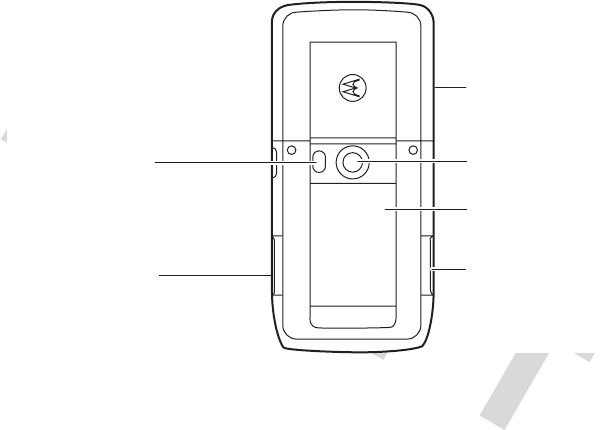
2
Accessary Connector Port
Insert battery charger &
phone accessories.
Primary Camera Lens
Memory Card
Slot
Camera Flash
& Camera On Indicator
Battery Cover
SIM Cover
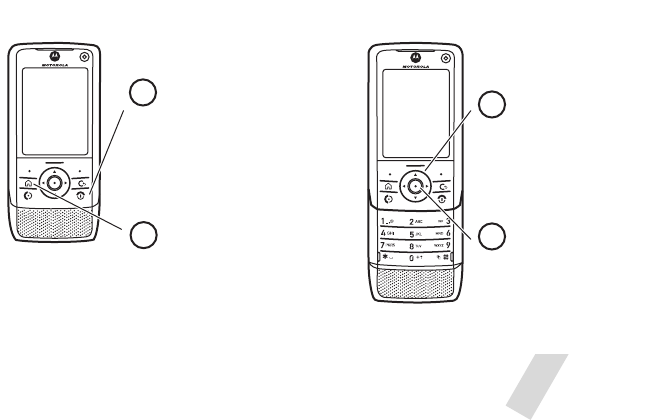
3
Home Screen Main Menu
Press and hold the
Power
Key
O
for a few
seconds or until the
display lights up to turn
on your phone.
1
Press the Navigation Key
up, down, left, or right
(
S
) to highlight a menu
feature.
3
Press the Centre Key
(
s
) to select it.
4
Press the Home Key to open
the
Main Menu
.
2
ContactsOptions Open HomeOptions Open

4
Motorola, Inc.
Consumer Advocacy Office
1307 East Algonquin Road
Schaumburg, IL 60196
www.hellomoto.com
Certain mobile phone features are dependent on the capabilities
and settings of your service provider’s network. Additionally,
certain features may not be activated by your service provider,
and/or the provider's network settings may limit the feature’s
functionality. Always contact your service provider about feature
availability and functionality. All features, functionality, and other
product specifications, as well as the information contained in this
user's guide are based upon the latest available information and
are believed to be accurate at the time of printing. Motorola
reserves the right to change or modify any information or
specifications without notice or obligation.
MOTOROLA and the Stylised M Logo are registered in the US
Patent & Trademark Office. All other product or service names are
the property of their respective owners. The Bluetooth trademarks
are owned by their proprietor and used by Motorola, Inc. under
license. Java and all other Java-based marks are trademarks or
registered trademarks of Sun Microsystems, Inc. in the U.S. and
other countries. Microsoft, Windows and Windows Me are
registered trademarks of Microsoft Corporation; and Windows XP
is a trademark of Microsoft Corporation.
© Motorola, Inc., 2007.
Caution:
Changes or modifications made in the radio phone, not
expressly approved by Motorola, will void the user’s authority to
operate the equipment.
Software Copyright Notice
The Motorola products described in this manual may include
copyrighted Motorola and third-party software stored in
semiconductor memories or other media. Laws in the United
States and other countries preserve for Motorola and third-party
software providers certain exclusive rights for copyrighted
software, such as the exclusive rights to distribute or reproduce
the copyrighted software. Accordingly, any copyrighted software
contained in the Motorola products may not be modified,
reverse-engineered, distributed, or reproduced in any manner to
the extent allowed by law. Furthermore, the purchase of the
Motorola products shall not be deemed to grant either directly or
by implication, estoppel, or otherwise, any license under the
copyrights, patents, or patent applications of Motorola or any
third-party software provider, except for the normal, non-exclusive,
royalty-free license to use that arises by operation of law in the
sale of a product.
Manual Number: 68XXXXX178-O

contents
5
contents
menu map. . . . . . . . . . . . 7
Safety Information . . . . . 8
FCC Notice . . . . . . . . . . 13
Use and Care . . . . . . . . 14
EU Conformance . . . . . 15
Recycling Information . 16
essentials . . . . . . . . . . . 17
about this guide . . . . . 17
SIM card . . . . . . . . . . . 17
battery . . . . . . . . . . . . 18
memory card . . . . . . . 20
turn it on & off . . . . . . 21
slider. . . . . . . . . . . . . . 22
make a call . . . . . . . . . 22
answer a call. . . . . . . . 22
store a phone number 22
call a stored phone
number. . . . . . . . . . . . 23
your phone number . . 23
main attractions . . . . . . 24
Home screen . . . . . . . 24
video calls. . . . . . . . . . 25
messaging . . . . . . . . . 25
contacts . . . . . . . . . . . 27
media studio. . . . . . . . 28
Bluetooth™ wireless . 37
web browser . . . . . . . 40
connect your phone to a
computer . . . . . . . . . . 42
phone updates . . . . . . 44
basics. . . . . . . . . . . . . . . 45
basic navigation . . . . . 45
Home screen . . . . . . . 46
main menu . . . . . . . . . 46
status indicators . . . . . 47
text entry . . . . . . . . . . 49
volume . . . . . . . . . . . . 51
lock and unlock keypad 52
handsfree speaker . . . 52
customise . . . . . . . . . . . 53
profiles . . . . . . . . . . . . 53
Home screen . . . . . . . 55
managing themes. . . . 55
time & date. . . . . . . . . 56
answer options. . . . . . 56
calls . . . . . . . . . . . . . . . . 57
turn off a call alert . . . . 57
recent calls . . . . . . . . . 57
return a call . . . . . . . . . 57
redial. . . . . . . . . . . . . . 58

6
contents
caller ID . . . . . . . . . . . . 58
emergency calls . . . . . 58
voicemail . . . . . . . . . . . 59
other features . . . . . . . . 60
advanced calling . . . . . 60
restrict calls and
messages . . . . . . . . . . 62
contacts. . . . . . . . . . . . 63
messaging. . . . . . . . . . 66
device settings . . . . . . 68
call times & costs . . . . 68
data calls . . . . . . . . . . . 69
network . . . . . . . . . . . . 70
calendar . . . . . . . . . . . . 71
tools. . . . . . . . . . . . . . . 72
security . . . . . . . . . . . . 73
pictures, videos and
games . . . . . . . . . . . . . 74
flight mode . . . . . . . . . 75
advanced Bluetooth
features . . . . . . . . . . . . 76
memory card . . . . . . . . 77
protected content . . . . 78
service and repairs . . . . 79
SAR Data . . . . . . . . . . . . 80
Warranty. . . . . . . . . . . . . 81
WHO Information . . . . . 85
index. . . . . . . . . . . . . . . . 86

menu map
7
menu map
main menu
E
Messaging
• Create message
• Call voicemail
• Messages Inbox
• Email Inbox
A
Contacts
D
Calendar
q
Web
B
Recent Calls
•All
• Dialled
•Missed
• Received
G
Control panel
• Profiles
• Speed Dial
• Themes
• Home Screen
• Call Settings
•Install
• Uninstall
• Media Studio
• Audio Routing
•Device
• Contacts
• Kill Filters
• Security
• Rights Manager
• Messaging Settings
•Voicemail
• Internet Settings
• Network Settings
• Download Manager
F
Media Studio
• Media Player
•Camera
• Camcorder
• Media Gallery
•Voice
C
Connectivity
• Bluetooth™
• Remote sync
• Connections
• USB Selector
I
To o l s
•Time
•To Do
• Calculator
•Jotter
• File Manager
• Storage wizard
K
SIM
• SIM Toolkit
• SIM Application
L
Games
•Vibe
This is the standard main menu layout. Your
phone’s menu may be a little different.
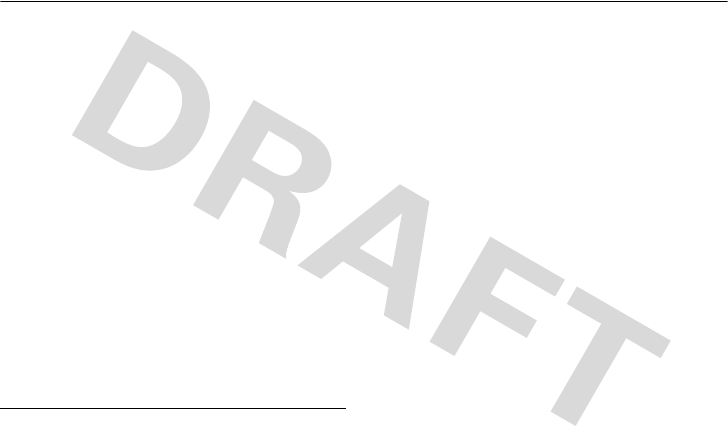
8
Safety Information
Safety and General Information
Safe ty Infor mation
This section contains important information on the safe and
efficient operation of your mobile device. Read this
information before using your mobile device.
*
Exposure to Radio Frequency (RF)
Energy
Your mobile device contains a transmitter and receiver. When it is
ON, it receives and transmits RF energy. When you communicate
with your mobile device, the system handling your call controls the
power level at which your mobile device transmits.
Your Motorola mobile device is designed to comply with local
regulatory requirements in your country concerning exposure of
human beings to RF energy.
Operational Precautions
For optimal mobile device performance and to be sure that human
exposure to RF energy does not exceed the guidelines set forth in
the relevant standards, always follow these instructions and
precautions.
External Antenna Care
If your mobile device has an external antenna, use only a
Motorola-supplied or approved replacement antenna. Use of
unauthorised antennas, modifications, or attachments could
damage the mobile device and/or may result in your device not
complying with local regulatory requirements in your country.
DO NOT hold the external antenna when the mobile device is IN
USE. Holding the external antenna affects call quality and may
cause the mobile device to operate at a higher power level than
needed.
Product Operation
When placing or receiving a phone call, hold your mobile device
just like you would a landline phone.
If you wear the mobile device on your body, always place the
mobile device in a Motorola-supplied or approved clip, holder,
holster, case, or body harness. If you do not use a body-worn
accessory supplied or approved by Motorola, keep the mobile
device and its antenna at least 2.5 centimeters (1 inch) from your
body when transmitting.
* The information provided in this document supersedes the general
safety information in user’s guides published prior to May 1, 2006.

Safety Information
9
When using any data feature of the mobile device, with or without
an accessory cable, position the mobile device and its antenna at
least 2.5 centimeters (1 inch) from your body.
Using accessories not supplied or approved by Motorola may
cause your mobile device to exceed RF energy exposure
guidelines. For a list of Motorola-supplied or approved
accessories, visit our Web site at:
www.motorola.com
.
RF Energy Interference/Compatibility
Nearly every electronic device is subject to RF energy interference
from external sources if inadequately shielded, designed, or
otherwise configured for RF energy compatibility. In some
circumstances your mobile device may cause interference with
other devices.
Follow Instructions to Avoid Interference
Problems
Turn off your mobile device in any location where posted notices
instruct you to do so. These locations include hospitals or health
care facilities that may be using equipment that is sensitive to
external RF energy.
In an aircraft, turn off your mobile device whenever instructed to
do so by airline staff. If your mobile device offers an airplane mode
or similar feature, consult airline staff about using it in flight.
Pacemakers
If you have a pacemaker, consult your physician before using this
device.
Persons with pacemakers should observe the following
precautions:
•
ALWAYS keep the mobile device more than
20 centimeters (8 inches) from your pacemaker when the
mobile device is turned ON.
•
DO NOT carry the mobile device in the breast pocket.
•
Use the ear opposite the pacemaker to minimise the
potential for interference.
•
Turn OFF the mobile device immediately if you have any
reason to suspect that interference is taking place.
Hearing Aids
Some mobile devices may interfere with some hearing aids. In the
event of such interference, you may want to consult your hearing
aid manufacturer or physician to discuss alternatives.
Other Medical Devices
If you use any other personal medical device, consult your
physician or the manufacturer of your device to determine if it is
adequately shielded from RF energy.
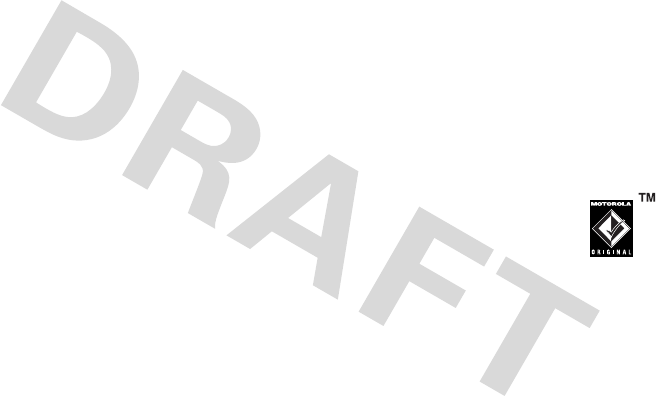
10
Safety Information
Driving Precautions
Check the laws and regulations on the use of mobile devices in the
area where you drive. Always obey them.
When using your mobile device while driving, please:
•
Give full attention to driving and to the road. Using a
mobile device may be distracting. Discontinue a call if you
can’t concentrate on driving.
•
Use handsfree operation, if available.
•
Pull off the road and park before making or answering a
call if driving conditions so require.
Responsible driving practices can be found in the “Smart Practices
While Driving” section at the end of this guide and/or at the
Motorola Web site:
www.motorola.com/callsmart
.
Operational Warnings
Obey all posted signs when using mobile devices in public areas,
such as health care facilities or blasting areas.
Automobile Air Bags
Do not place a mobile device in the air bag deployment area.
Potentially Explosive Atmospheres
Areas with potentially explosive atmospheres are often but not
always posted, and can include fueling areas such as below decks
on boats, fuel or chemical transfer or storage facilities, or areas
where the air contains chemicals or particles, such as grain, dust,
or metal powders.
When you are in such an area, turn off your mobile device, and do
not remove, install, or charge batteries. In such areas, sparks can
occur and cause an explosion or fire.
Damaged Products
If your mobile device or battery has been submerged in water,
punctured, or subjected to a severe fall, do not use it until you take
it to a Motorola Authorised Service centre. Do not attempt to dry it
with an external heat source, such as a microwave oven.
Batteries and Chargers
If jewelry, keys, beaded chains, or other conductive
materials touch exposed battery terminals, this
could complete an electrical circuit (short circuit),
become very hot, and could cause damage or
injury. Be careful when handling a charged battery,
particularly when placing it inside a pocket, purse, or other
container with metal objects.
Use only Motorola Original
batteries and chargers.
Caution:
To avoid risk of personal injury, do not dispose of your
battery in a fire.
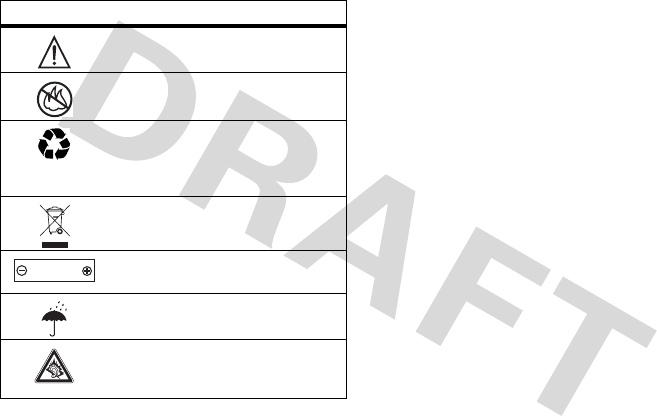
Safety Information
11
Your battery, charger, or mobile device may contain symbols,
defined as follows:
Choking Hazards
Your mobile device or its accessories may include detachable
parts, which may present a choking hazard to small children. Keep
your mobile device and its accessories away from small children.
Glass Parts
Some parts of your mobile device may be made of glass. This glass
could break if the product is dropped on a hard surface or receives
a substantial impact. If glass breaks, do not touch or attempt to
remove. Stop using your mobile device until the glass is replaced
by a qualified service centre.
Seizures/Blackouts
Some people may be susceptible to epileptic seizures or blackouts
when exposed to flashing lights, such as when playing video
games. These may occur even if a person has never had a previous
seizure or blackout.
If you have experienced seizures or blackouts, or if you have a
family history of such occurrences, please consult with your
physician before playing video games or enabling a flashing-lights
feature (if available) on your mobile device.
Discontinue use and consult a physician if any of the following
symptoms occur: convulsion, eye or muscle twitching, loss of
awareness, involuntary movements, or disorientation. It is always
a good idea to hold the screen away from your eyes, leave the
Symbol Definition
Important safety information follows.
Do not dispose of your battery or mobile
device in a fire.
Your battery or mobile device may require
recycling in accordance with local laws.
Contact your local regulatory authorities
for more information.
Do not throw your battery or mobile device
in the trash.
Your mobile device contains an internal
lithium ion battery.
Do not let your battery, charger, or mobile
device get wet.
Listening at full volume to music or voice
through a headset may damage your
hearing.
032374o
032376o
032375o
032378o
Li Ion BATT

12
Safety Information
lights on in the room, take a 15-minute break every hour, and stop
use if you are very tired.
Caution About High Volume Usage
Listening at full volume to music or voice through a
headset may damage your hearing.
Repetitive Motion
When you repetitively perform actions such as pressing keys or
entering finger-written characters, you may experience occasional
discomfort in your hands, arms, shoulders, neck, or other parts of
your body. If you continue to have discomfort during or after such
use, stop use and see a physician.

FCC Notice
13
FCC Notice To Users
FCC N otic e
The following statement applies to all products that have
received FCC approval. Applicable products bear the FCC
logo, and/or an FCC ID in the format FCC-ID:xxxxxx on the
product label.
Motorola has not approved any changes or modifications to this
device by the user. Any changes or modifications could void the
user’s authority to operate the equipment. See 47 CFR Sec. 15.21.
This device complies with part 15 of the FCC Rules. Operation is
subject to the following two conditions: (1) This device may not
cause harmful interference, and (2) this device must accept any
interference received, including interference that may cause
undesired operation. See 47 CFR Sec. 15.19(3).
If your mobile device or accessory has a USB connector, or is
otherwise considered a computer peripheral device whereby it can
be connected to a computer for purposes of transferring data, then
it is considered a Class B device and the following statement
applies:
This equipment has been tested and found to comply with the
limits for a Class B digital device, pursuant to part 15 of the FCC
Rules. These limits are designed to provide reasonable protection
against harmful interference in a residential installation. This
equipment generates, uses and can radiate radio frequency energy
and, if not installed and used in accordance with the instructions,
may cause harmful interference to radio communications.
However, there is no guarantee that interference will not occur in a
particular installation. If this equipment does cause harmful
interference to radio or television reception, which can be
determined by turning the equipment off and on, the user is
encouraged to try to correct the interference by one or more of the
following measures:
•
Reorient or relocate the receiving antenna.
•
Increase the separation between the equipment and the
receiver.
•
Connect the equipment to an outlet on a circuit different
from that to which the receiver is connected.
•
Consult the dealer or an experienced radio/TV technician
for help.
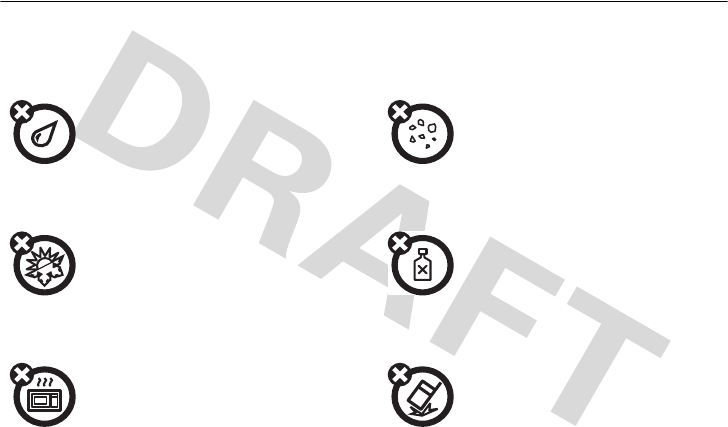
14
Use and Care
Use and Care
Use and Care
To care for your Motorola phone, please keep it away from:
liquids of any kind dust and dirt
Don’t expose your phone to water, rain,
extreme humidity, sweat, or other moisture.
Don’t expose your phone to dust, dirt, sand,
food, or other inappropriate materials.
extreme heat or cold cleaning solutions
Avoid temperatures below -10°C/14°F or
above 45°C/113°F.
To clean your phone, use only a dry soft cloth.
Don’t use alcohol or other cleaning solutions.
microwaves the ground
Don’t try to dry your phone in a microwave
oven.
Don’t drop your phone.
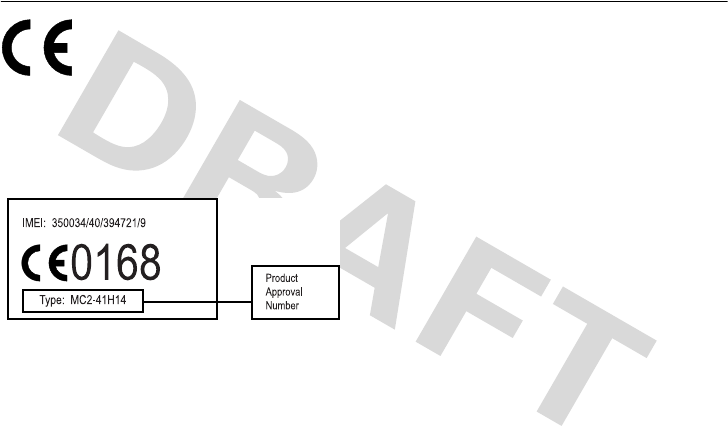
EU Conformance
15
European Union Directives Conformance Statement
EU Conformance
Hereby, Motorola declares that this product is in compliance with
•
The essential requirements and other relevant provisions
of Directive 1999/5/EC
•
All other relevant EU Directives
The above gives an example of a typical Product Approval Number.
You can view your product’s Declaration of Conformity (DoC) to
Directive 1999/5/EC (to R&TTE Directive) at
www.motorola.com/rtte
. To find your DoC, enter the
product Approval Number from your product’s label in the “Search”
bar on the web site.
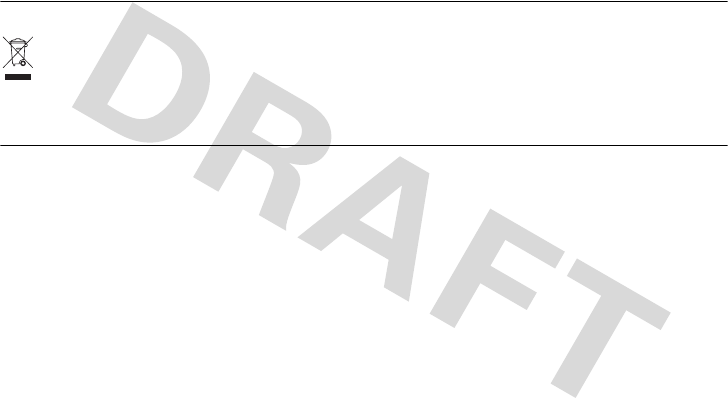
16
Recycling Information
Recycling Information
Caring for the Environment by Recycling
This symbol on a Motorola product means the product
should not be disposed of with household waste.
Disposal of your Mobile Telephone and Accessories
Please do not dispose of mobile telephones or electrical
accessories, such as chargers or headsets, with your household
waste. In some countries or regions, collection systems have been
set up to handle waste electrical and electronic items. Please
contact your regional authorities for more details. If no suitable
scheme exists, you may return unwanted mobile telephones and
electrical accessories to any Motorola Approved Service Centre in
your region.
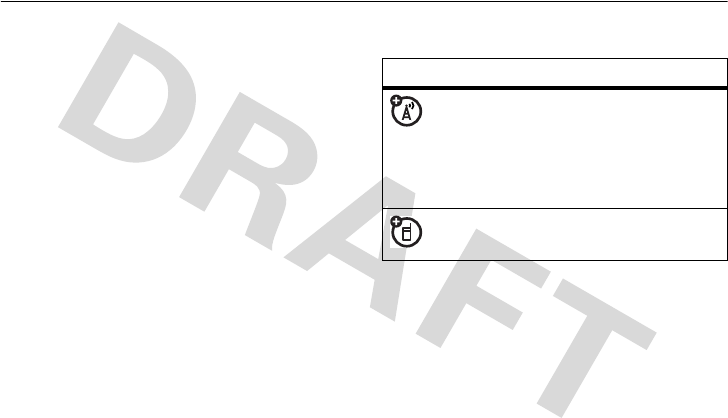
17
essentials
essentials
about this guide
This guide shows how to open a menu
feature as follows:
Find it:
g
>
EMessaging
>
Create new message
This means that, from the Home screen:
1
Press the home key
g
to open the main
menu.
2
Press the navigation key
S
to scroll to
EMessaging
, and press the centre key
s
to select it.
3
Press the navigation key
S
to scroll to
Create new message
, and press the
centre key
s
to select it.
SIM card
Caution:
Don’t bend or scratch your SIM card.
Keep it away from static electricity, water, and
dirt.
Yo u r Subscriber Identity Module (SIM) card
contains personal information like your phone
symbols
This means a feature is network,
SIM card, or subscription
dependent and may not be available
in all areas. Contact your service
provider for more information.
This means a feature requires an
optional accessory.
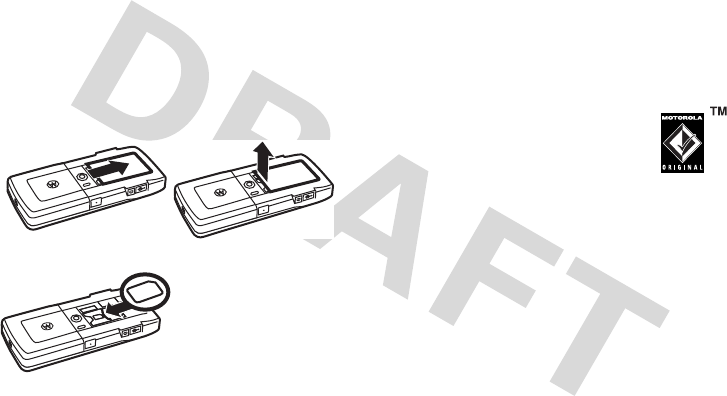
18
essentials
number and contacts entries. It can also
contain your voicemail, text message, and
Internet access settings. If you put your SIM
card in another phone, that phone uses your
phone number.
SIM installation
battery
battery tips
Battery life depends on the network, signal
strength, temperature, features, and
accessories you use.
•
Always use Motorola
Original batteries and
chargers. The warranty does
not cover damage caused by
non-Motorola batteries and/or chargers.
•
New batteries or batteries stored for a
long time may take more time to
charge.
•
When charging your battery, keep it
near room temperature.
When storing your battery, keep it
uncharged in a cool, dark, dry place.
12
3
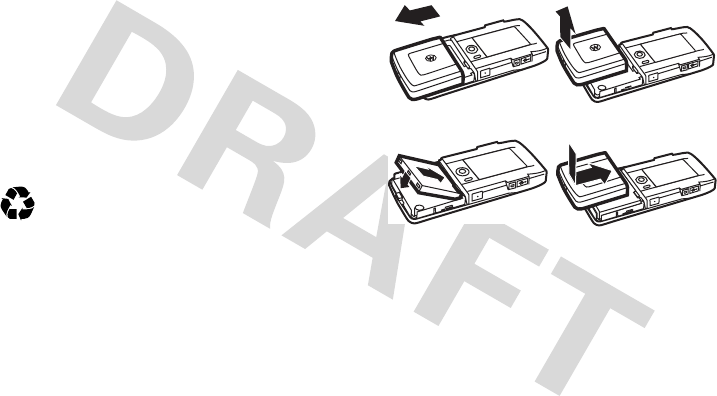
19
essentials
•
Never expose batteries to
temperatures below -10°C (14°F) or
above 45°C (113°F). Always take your
phone with you when you leave your
vehicle.
•
It is normal for batteries to gradually
wear down and require longer charging
times. If you notice a change in your
battery life, it is probably time to
purchase a new battery.
Contact your local recycling centre for
proper battery disposal.
Warning:
Never dispose of batteries in a fire
because they may explode.
Before using your phone, read the battery
safety information in the “Safety and General
Information” section included in this guide.
battery installation
Note:
Your battery is intentionally tight fitting
to ensure consistent connection.
032375o
12
34
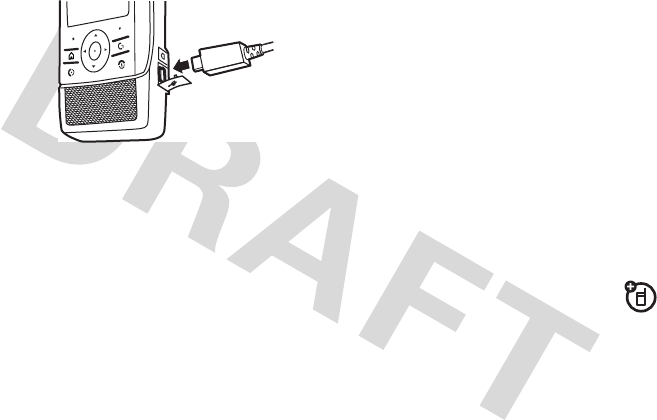
20
essentials
battery charging
New batteries
are not fully
charged. Plug
the battery
charger into
your phone
and an
electrical outlet. Your phone might take
several seconds to start charging the battery.
Your phone’s battery charging icon, in the
status bar, flashes while the battery is
charging, and stops flashing when the battery
is fully charged. Disconnect your charger once
charging is complete.
Note:
If your battery is completely discharged
the battery empty indicator (see page 1) lights
up when the phone is charging. Once your
phone is sufficiently charged the battery
empty indicator goes out and the battery
charging icon will be displayed.
Note:
When you connect your phone to a
computer with the USB cable, your phone will
also be charged, see page 42.
The battery charger shipped with this device
is designed for Motorola 3G mobile phones.
Other chargers might take longer to charge
your battery, or cause your calls to fail during
charging.
memory card
You can use a removable microSD™
memory card with your phone to store
and retrieve multimedia objects (such as
photos and sounds). Some applications, such
as
Camera
and
Camcorder
, allow you to store
photos or videos on your phone or memory
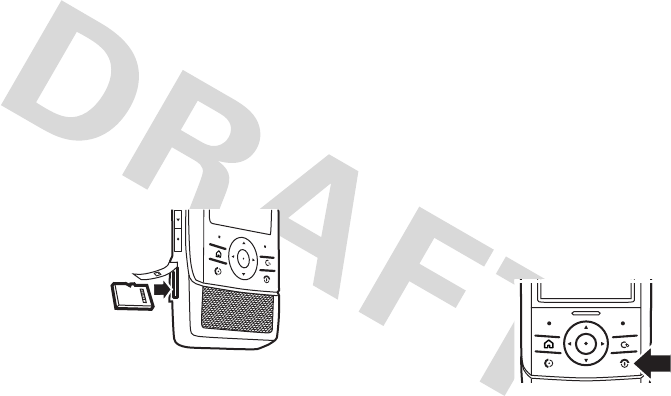
21
essentials
card. For more memory card features, see
page 77.
Note:
If you download a copyrighted file and
store it on your memory card, you can use the
file only while your memory card is inserted in
your phone. You cannot send, copy, or change
copyrighted files.
To transfer files to/from your memory card,
see page 42.
install or remove a memory card
1
Open the
rubber cover.
2 To install the
memory card
,
make sure the
memory card’s
metal contacts
are facing up, and slide the memory card
into the slot until you hear a click.
To remove the memory card
, push it in
and release. The memory card slides a
little way out of the slot. Pull the memory
card out of the slot.
3
Replace the rubber cover.
turn it on & off
Caution:
Some phones ask for your SIM card
PIN code when you turn them on. If you enter
an incorrect PIN code three times before the
correct code, your SIM card is disabled, and
your display shows
SIM Blocked
. Contact your
service provider.
To t u r n o n y o u r
phone
, press and hold
O
for a few seconds.
If prompted, enter your
SIM card PIN.

22
essentials
To turn off your phone
, press and hold
O
.
The power menu is briefly displayed. Continue
to hold
O
to turn off your phone.
Tip:
Release
O
when the power menu is
displayed and you can select
Shut down
,
Lock keypad
, and
Flight Mode
.
slider
To open your slider
, push the bumper bar up,
see page 1.
To close your slider
, pull the bumper bar
down.
make a call
To make a call
, enter a phone number and
press
N
.
To “hang up,”
close the slider or
press
O
.
Tip:
For the best microphone performance
have the slider open during a call.
To make video calls, see page 25.
answer a call
To answer a call
when your phone rings
and/or vibrates, just open the slider or press
N
.
To “ h a n g u p ,”
close the slider or press
O
.
store a phone number
You can store a phone number in your
Contacts
:
1
Enter a phone number in the Home
screen.
2
Press
Options
>
Store.

23
essentials
3
Enter a name and other details for the
phone number. To select a highlighted
item, press the centre key
s
.
4
Press
Options
>
Save
to store the number.
Note:
The number will be stored on your
phone’s memory.
For further
Contacts
details, see page 27.
call a stored phone
number
Find it:
g
>
A
Contacts
1
Scroll to the contacts entry.
Shortcut:
In contacts, press keypad keys
to enter the first letters of an entry you
want.
2
Press
N
to call the entry.
your phone number
From the Home screen, press
g
>
SIM
>
SIM Application
>
My Lines
to see your number.
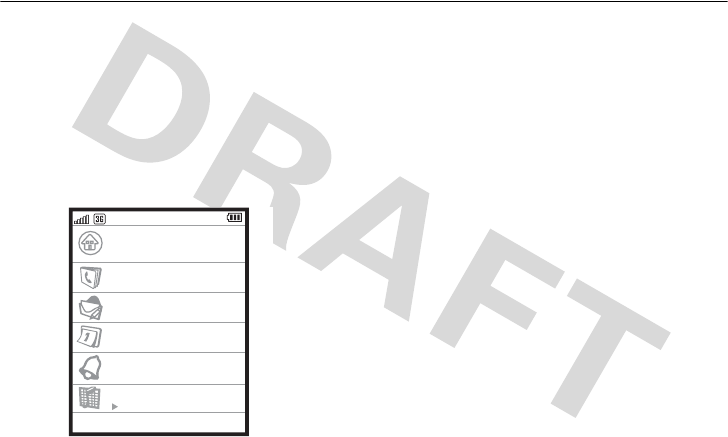
24
main attractions
main attractions
You can do much more with your phone than
make and receive calls!
Home screen
The Home screen appears when you turn on
the phone.
Note:
Your Home screen might look different
from the one shown, depending on your
service provider and selected plug-ins.
Your Home screen displays important status
information, such as messages and missed
calls using plug-ins. The following plug-ins can
be selected:
•Calls
- Select to view missed calls or
call a contact.
•Messages
- Select to view or send
messages.
•Email
- Select to view or send email.
• Calendar
- Select to view calendar
reminders.
Options OpenContacts
Service Provider
10/Jan/2007 12:00am
Call a contact
Send a message
Jan 10, 2007
Ring
Active profile: General
Live Music Info
00:00

25
main attractions
• Profile
- Select to view current profile
and settings.
•Music
- Select to play music and
access the
Media Gallery
.
In your Home screen menu press
Options
>
Settings
to select the plug-ins you want to
display. You can display up to five plug-ins.
To clear your plug-in status information
highlight the plug-in, then press and hold
D
.
For further Home screen features, see
page 46.
To customise your Home screen, see
page 55.
video calls
If you call someone who has a 3G video
phone, you can see each other while
you talk. If your phone is roaming on a
non-3G network
, video calls will not work
(see the Roam indicator on page 47).
make a video call
1
Enter a phone number and press the
video call key or press
Options
>
Video call
to
dial the number. For the video call key
location, see page 1.
2
To end the call, press
O
.
messaging
You can send and receive SMS, MMS, and
email messages from the messaging feature.
For more messaging features, see page 66.
send a message
Find it:
g
>
EMessaging
>
Create new message
>
SMS
or
MMS
or
Email

26
main attractions
1
Select
To
to add a recipient. Enter the
recipient’s number or address, or press
Contacts
and select a contact.
2
Select
Subject
to enter a subject (optional).
3
Scroll down to the text entry field and
press keypad keys to enter text on the
page (for details about text entry, see
page 49).
To i ns e r t a
picture, sound, or other
object
on the page, press
Options
and
select the
Add
or
Insert
menu.
To i ns e r t
another page
in your MMS,
press
Options
>
Add
>
New page
. You can
enter more text and objects on the new
page.
SMS, MMS and email messages allow
different types of objects to be added to
your message. All available options are
displayed in the
Add
and
Insert
menus.
4
When you finish the message, press the
Send
key to
send
the message.
receive a message
When you receive a new message, your
phone plays an alert. Also, the display
shows
New message
with a message indicator,
such as
É
, and the Home screen messaging
plug-in is updated. Press the
View
key to open
the message.
To see all of your messages:
Find it:
g
>
EMessaging
>
Messages Inbox
or
Email Inbox
Tip:
You can use the
S
left and right keys to
scroll between folders, such as
Inbox
,
Outbox
,
Draft
,
Sent
,
SIM
, and
Templates
.

27
main attractions
contacts
You can manage the details of your contacts
from the contacts feature.
For more contacts features, see page 63.
create a contact
You can store phone numbers, email
addresses, postage addresses and much
more for each contact in your contacts list.
Find it:
g
>
AContacts
>
Options
>
New contact
1
Enter a name and other details for the
contact. To select a highlighted item,
press the centre key
s
.
2
Use the
S
left and right keys to scroll
between tabs, such as
Basic
,
Detail
, and
Notes
. Enter more details for the contact as
required.
3
Press
Options
>
Save
to store the contact.
use a contact
With a contact highlighted you can:
•
press the centre key
s
to display the
contacts details.
Tip:
Use the
S
left and right keys to
scroll between tabs, such as
Basic
,
Detail
,
and
Notes
. For SIM contacts you can
only store
Basic
information. If you want
to store additional information then the
contact must be stored on your
phone’s memory.
•
press the
S
left and right keys to view
individual details, such as Mobile
number, Phone number, and email
address.
Tip:
With a number displayed, just
press
N
to call the contact.
•
press
Options
to make a voice call, make
a video call, send a message and more.

28
main attractions
SIM and phone contacts
You can show contacts stored in your
phone’s
memory
or on your
SIM card
. Press
g
>
A
Contacts
then press
Options
>
View category
>
All
phone contacts
or
SIM
.
To store a SIM contact, set your category to
SIM
and create a contact from the Contacts
feature.
To store a phone contact, set your category to
All phone contacts
or another category you have
created and create a contact from the
Contacts feature or the Home screen.
To copy contacts between your phone and
SIM, see page 65.
media studio
Your phone’s media studio contains:
• Camera
• Camcorder
• Media Gallery
• Media Player
• Voice recorder
camera
Your primary camera lens is on the back of
your phone, and your secondary camera lens
is on the front of your phone (see page 1).
To
get the clearest pictures, wipe the lens
clean with a soft dry cloth before you take
a picture.
Note:
Next to the camera lens on the
back of your phone is a
camera on
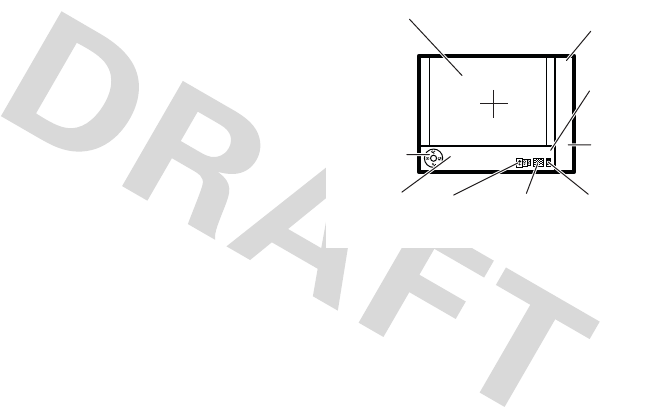
29
main attractions
indicator
. This can blink when your camera is
on to let people around you know that they
might be in your photo or video.
take a photo
Note:
To take a photo with the primary
camera your slide must be closed. To take a
photo with your secondary camera the slide
must be open (see page 1).
1
Press the camera key or
g
>
FMedia
Studio
>
Camera
to see the viewfinder.
2
Press the camera key or the
centre key
s
to take the photo in the
viewfinder.
Viewfinder
Window
Use Navigation
Key to select
function
Mode
Indicator
Size
Indicator
Quality
Indicator Icon
Right Soft
Key
Number of
pictures
available
Left Soft Key
Storage
Indicator Icon
Options Back
Camera 240
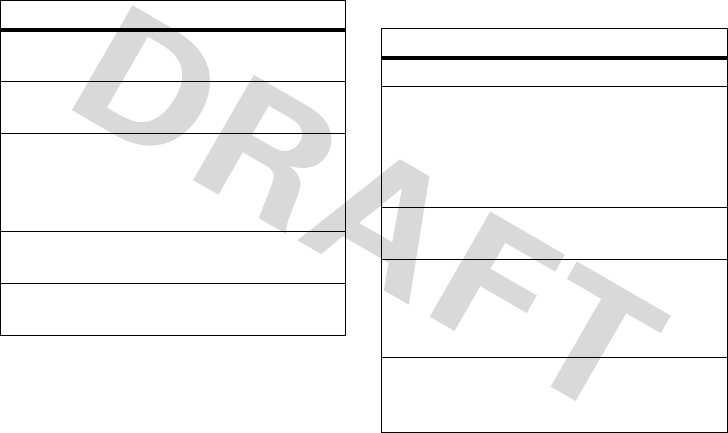
30
main attractions
After you capture your photo, you can use the
navigation keys:
photo features
Before you capture your photo, you can press
Options
to open the camera menu:
keys
centre Save and return to
viewfinder.
up Save the photo and go to
the
Media Gallery
.
down Save the photo and create
an MMS message with
the photo inserted in the
message.
left Save and return to
viewfinder.
right Discard and return to
viewfinder.
options
Capture
Capture the photo.
Picture size
Adjust your picture size
between
Small
(QVGA),
Medium
(VGA), and
Large
(2MP - primary camera
only).
Picture quality
Adjust your picture quality
between
Standard
and
Fine
.
Modes
Change the mode of your
camera (
Normal
,
Indoor
,
Outdoor
,
Sports
,
Portrait
,
Night
,
and
Backlight
).
Effects
Change the effect of your
photo (
None, Black & White
,
Negative
,
Sepia
, and
Solarise
).
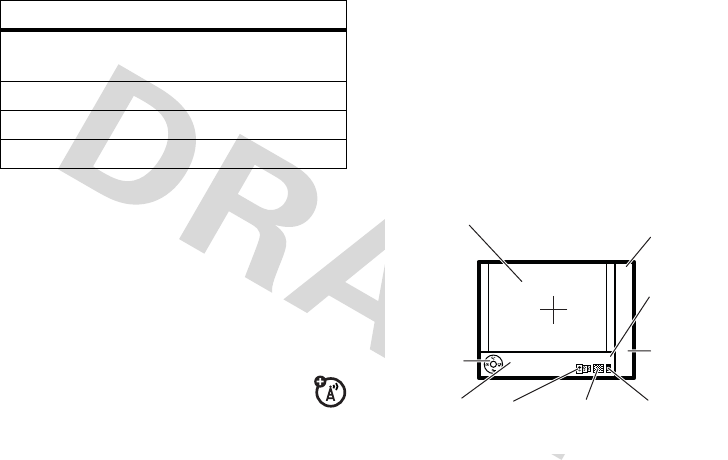
31
main attractions
camcorder
Your primary camera lens is on the back of
your phone, and your secondary camera lens
is on the front of your phone (see page 1).
To
get the clearest pictures, wipe the lens
clean with a soft dry cloth before you take
a picture.
Note:
Next to the camera lens on the
back of your phone is a
camera on
indicator
. This can blink when your camera is
on to let people around you know that they
might be in your photo or video.
record a video
Note:
To take a video with the primary
camera your slide must be closed. To take a
video with your secondary camera the slide
must be open (see page 1).
1
Press the camera key then the right
navigation key or
g
>
FMedia Studio
>
Camcorder
to see the viewfinder.
Flash Mode
Set your flash mode to
Always on
,
On once
or
Off
.
Red eye reduction
Turn
RedEye
On
or
Off
.
Self timer
Turn the self timer
On
or
Off
.
Settings
Set more camera features.
options
Viewfinder
Window
Use Navigation
Key to select
function
Mode
Indicator
Size
Indicator
Quality
Indicator Icon
Right Soft
Key
Time available
Left Soft Key
Storage
Indicator Icon
Options Back
Camcorder 58:43
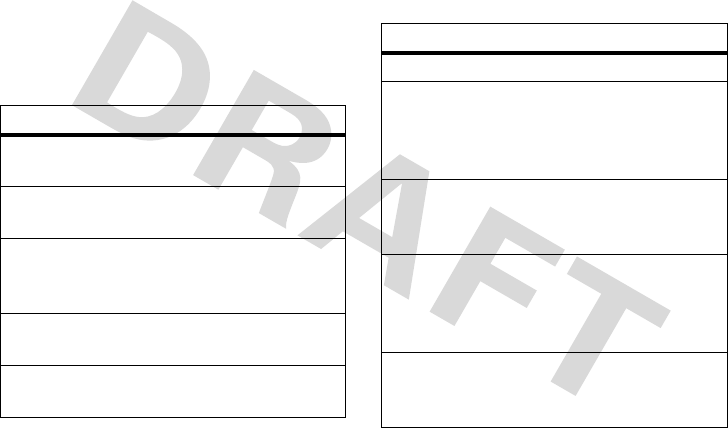
32
main attractions
2
Press the camera key or the
centre key
s
to start recording.
3
Press the camera key or the
centre key
s
to stop recording.
After you record your video, you can use the
navigation keys:
video features
Before you capture your video, you can press
Options
to open the camcorder menu:
keys
centre Play/Pause (preview) the
video.
up Save the video and go to
the
Media Gallery
.
down Save and go to the MMS
editor with the video
inserted in the message.
left Save and return to
viewfinder.
right Discard and return to
viewfinder.
options
Record
Record the video.
Video Size
Adjust your video size
between
Small
(SQCIF),
Medium
(QCIF), and
Large
(QVGA).
Video Quality
Adjust your video quality
between
Low
,
Medium
, and
High
.
Modes
Change the mode of your
video (
Normal
,
Indoor
,
Outdoor
,
Sports
,
Portrait
,
Night
, and
Backlight
).
Effects
Change the effect of your
photo (
None, Black & White
,
Negative
,
Sepia
, and
Solarise
).
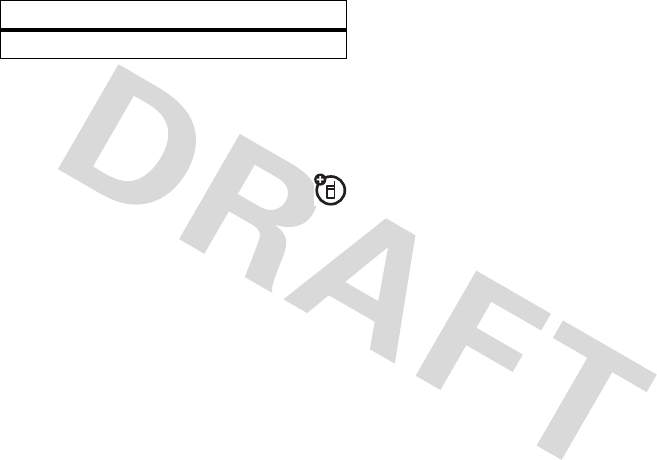
33
main attractions
media gallery
Use the Media Gallery to manage your
multimedia content.
Tip:
You can use a removable memory
card with your phone to store more
media files (see page 20).
Find it:
g
>
FMedia Studio
>
MediaGallery
play music
In the Media Gallery, press
S
left or right to
scroll to the music tab. Select a track from
Playlists
,
Artists
,
Tracks
or
Albums
to start playing
music.
For more music and media player details, see
page 34.
view photos
In the Media Gallery, press
S
left or right to
scroll to the photos tab. Select a photo to
view it. You can now press
S
left or right to
scroll through your photos.
To edit, or delete photos you’ve taken, see
page 74.
play videos
In the Media Gallery, press
S
left or right to
scroll to the videos tab. Select a video to start
playing it. You can now use the navigation key
S
to play, pause, forward and rewind your
video.
To delete, or manage videos you’ve recorded,
see page 74.
play sounds and ring tones
In the Media Gallery, press
S
left or right to
scroll to the sounds and ring tones tab. Select
a sound or ring tone to start playing it.
Settings
Set more video features.
options
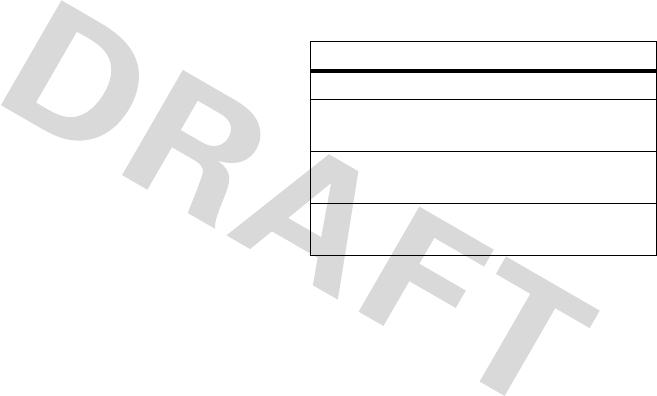
34
main attractions
download multimedia
To download music tracks, videos, pictures,
sounds or ring tones from the Internet, see
page 74.
media player
play music
Your phone can play and store AAC, AAC Plus,
Enhanced AAC and MP3 music files.
Note:
Your phone may not play MP3 files that
have a bit rate higher than 128 kbps. If you try
to download or play one of these files, your
phone might show you an error or ask you to
delete the file.
Find it:
Press the media player key or
g
>
FMedia Studio
>
MediaPlayer
. For the
media player key location, see page 1.
If no tracks or playlists are loaded, you are first
taken to the Media Gallery to select a song to
play. From the music tab, open one of the
following:
Once the Media Player is displayed:
• Play or pause
the song by pressing
the centre key
s
.
Tip:
You can also play or pause by
pressing the media player key.
tab
Playlists
Play and manage your playlists.
Artists
Select an artist to show or play
their songs.
Tracks
Select a track to show or play
songs.
Albums
Select an album to show or play
its songs.
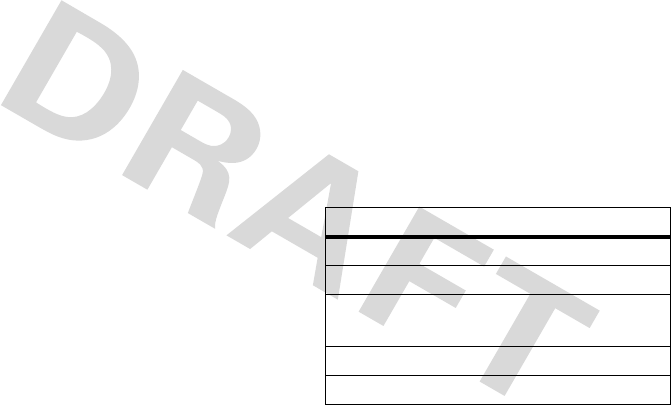
35
main attractions
•Stop
the song by pressing
S
down.
• Play previous or next
by pressing
S
left or right.
• Change volume
by pressing the
volume keys.
• Return to the Media Gallery
by
pressing
S
up. Your music will
continue to play.
• Hide the player
by pressing
g
to
return to the main menu. This lets you
use other phone features while playing
music.
Note:
The Media Player is used to play music
and videos. You cannot play both at the same
time.
Tip:
You can listen to music as you travel. Use
Bluetooth™ A2DP enabled devices, such as
stereo headphones, for enhanced music
quality and use Bluetooth AVRCP enabled
devices, such as car stereos, to control
playback (see page 37). If you’re on a plane,
use a wired headset and flight mode to make
your phone safe to use (see page 75).
manage playlists
Find it:
g
>
FMedia Studio
>
MediaGallery
>
Music
tab >
Playlists
Press
S
up or down to scroll to a Playlist,
and press the centre key
s
to select it or
press
Options
to open the menu:
options
Open
Show your playlists.
Play
Play your selected playlist.
New
Playlist
Create a new playlist (see
below).
Rename
Rename a playlist.
Delete
Delete a playlist.
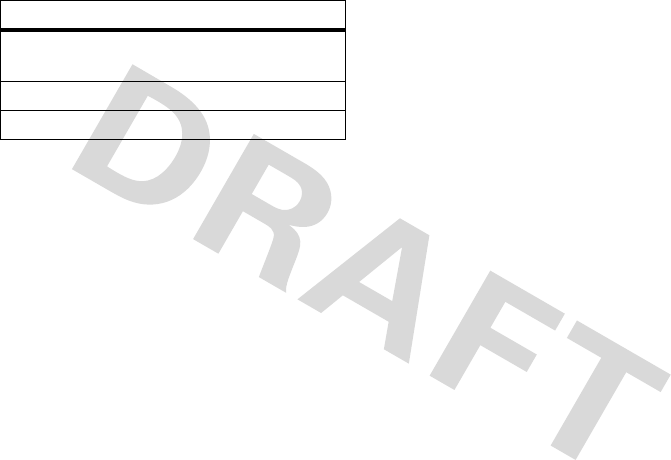
36
main attractions
To
create a playlist
:
1
In the
Playlists
tab press
Options
>
New playlist
.
2
Enter a name for your playlist and save the
changes.
3
Open a song list, select each song you
want to add and save your changes.
music router
To select which device you want to use to play
your music or multimedia audio, such as
handsfree headset or music system.
Find it:
g
>
GControl panel
>
Audio Routing
play videos
Find it:
g
>
FMedia Studio
>
MediaGallery
>
Videos
tab
Scroll to the video you want to play and press
the centre key
s
. Once the Media Player is
displayed:
• Play or pause
the video by pressing
the centre key
s
.
•Stop
the video by pressing
S
down.
• Skip back or forward
by pressing
S
left or right.
•Change volume
by pressing the
volume keys.
• Return to the Media Gallery
by
pressing
S
up.
Note:
The Media Player is used to play music
and videos. You cannot play both at the same
time.
Sort by
Sort your playlists by
Name
or
Date
.
Find
Search for a playlist.
Details
View details of a playlist.
options

37
main attractions
voice recorder
Find it:
g
>
FMedia Studio
>
Voice
Press the centre key
s
to start and stop
recording. Your recorded sounds are saved in
the
MediaGallery
sounds/ring tones folder.
Bluetooth™ wireless
Your phone supports Bluetooth wireless
connections. You can connect your phone
with a Bluetooth audio device, such as a
handsfree headset or music system. You can
also connect your phone with a phone or
computer that supports Bluetooth
connections to exchange files.
Note:
The use of wireless phones while
driving may cause distraction. Discontinue a
call if you can’t concentrate on driving.
Additionally, the use of wireless devices and
their accessories may be prohibited or
restricted in certain areas. Always obey the
laws and regulations on the use of these
products.
For maximum Bluetooth security
, you
should always connect Bluetooth devices in a
safe, private environment.
use a handsfree or music
device
Before you try to connect your phone with
a handsfree or music device
, make sure the
device is
on
and
ready
in pairing or bonding
mode (see the user’s guide for the device).
Find it:
g
>
CConnectivity
>
Bluetooth
>
Enabled audio devices
tab >
New device
If Bluetooth is switched off, you will be
prompted to turn it on. Your phone now lists
the devices it finds within range:

38
main attractions
1
Scroll to a device in the list and press the
centre key
s
.
2
If necessary, press the
Yes
or
OK
key to
connect to the device.
3
If necessary, enter the device passkey
(such as
0000
) and press the
OK
key.
When your phone is connected, the
Bluetooth indicator
O
is highlighted in the
status bar.
Shortcut:
When your phone’s
Bluetooth power is on, your phone can
automatically connect to a handsfree device
you have used before. Just turn on the device,
or move it near the phone. If the device
doesn’t connect, turn it off and back on.
During a call, you can press
Options
>
Audio
>
Earpiece
to connect to a handsfree device you
have used before.
connect to another Bluetooth
device
Before you try to connect your phone with
another Bluetooth device
, make sure the
device is
on
.
Find it:
g
>
CConnectivity
>
Bluetooth
>
My devices
tab >
New device
If Bluetooth is switched off, you will be
prompted to turn it on. Your phone now lists
the devices it finds within range.
1
Scroll to a device in the list and press the
centre key
s
.
2
If necessary, press the
Yes
or
OK
key to
connect to the device.
3
If necessary, enter the device passkey
(such as
0000
) and press the
OK
key.

39
main attractions
When your phone is connected, the
Bluetooth indicator
O
is highlighted in the
status bar.
Shortcut:
When your phone’s
Bluetooth power is on, your phone can
automatically connect to a Bluetooth device
you have used before. Just turn on the device,
or move it near the phone. If the device
doesn’t connect, turn it off and back on.
send files to another device
You can send a media file, contacts
entry, calendar event and more from
your phone to a computer or other device.
Note:
You can’t copy some copyrighted
objects.
1
On your phone, scroll to the object that
you want to copy to the other device.
2
Press
Options
>
Send as
>
Bluetooth
.
3
Select a recognised device name, or
New
device
to search for the device where you
want to copy the file.
If your phone could not send the file to the
other device
, make sure the device is
on
and
ready
in discoverable mode (see the user’s
guide for the device). Also, make sure the
device is not busy with another similar
Bluetooth connection.
Note:
Once you connect your phone to a
Bluetooth device, that device can start similar
Bluetooth connections with your phone. Your
display shows the highlighted
Bluetooth indicator
O
in the status bar when
there is a Bluetooth connection.
receive files from another
device
If you do not see the Bluetooth
indicator
O
at the top of your display,
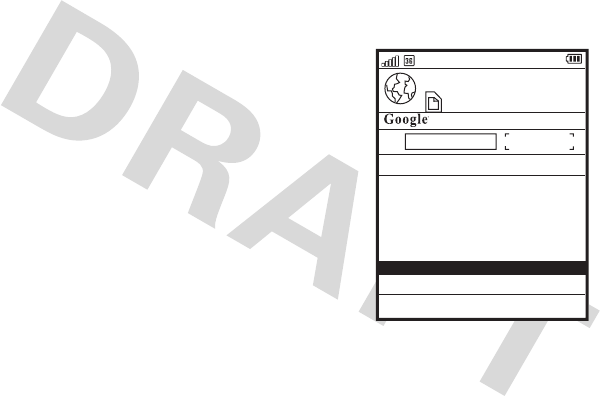
40
main attractions
turn on your phone’s Bluetooth feature by
pressing
g
>
CConnectivity
>
Bluetooth
>
Bluetooth on
.
1
Place your phone near the device, and
send the file from the device.
If your phone and the sending device
don’t recognise each other, place your
phone in discoverable mode so the
sending device can locate it:
press
g
>
CConnectivity
>
Bluetooth
>
Visible
to other devices
.
2
Press the
Accept
key on your phone to
accept the file from the other device.
Your phone notifies you when file transfer is
complete. A Bluetooth message is received in
your Messaging inbox.
web browser
Your phone is provided with a fully featured
WEB and WAP browser so you can connect
to the Internet.
To start your Internet connection press
g
>
qWeb
.
Web
OptionsBack
Search
The Best Internet Experience
>>
Portal
>>
News
>>
Community
>>
Software
Edit
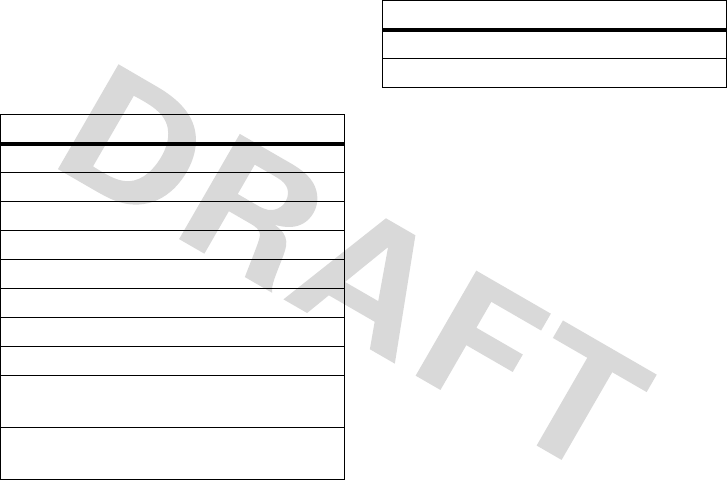
41
main attractions
Use the navigation key
S
to scroll between
items on the page.
Your browser provides shortcuts to common
tasks from the
Options
menu:
To download music, videos, pictures, and
more from the Internet, see page 74.
open a web page
1
Press
Options
>
Open web page
and enter the
web address, such as
www.motorola.com.
2
If necessary, select
Open in new page
.
3
Press
Options
>
Open
.
key shortcut
1
Open a web page.
2
Go to Bookmarks.
3
Close current window.
4
Go to your home page.
5
Show images.
6
Display in full screen mode.
7
Display the next browser window.
8
Set your Internet preferences.
9
Add the current web page to your
Bookmarks
0
Stop (when page is loading) or
refresh the current page.
#
Go to the top or bottom of the page.
*
Find text on the current page.
key shortcut
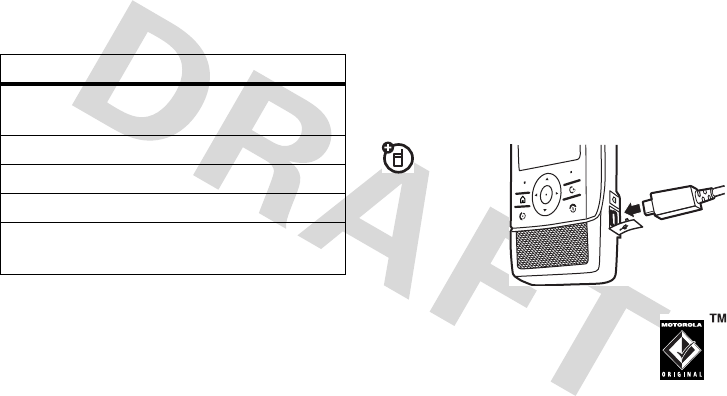
42
main attractions
manage bookmarks
To see your bookmarks press
Options
>
Bookmarks
. To manage your bookmarks
press
Options
to open the bookmarks menu:
screen format
You can choose the screen format used to
display your web pages.
Press
Options
>
Settings
and select one or more
from
Fit to screen
,
Full screen
, and
Landscape
.
connect your phone to a
computer
You can use a USB cable or a Bluetooth
connection to connect your phone to a
computer.
cable connection
Yo u r
phone
has a mini-USB
port so you can
connect it to a
computer to
transfer data.
Note:
Motorola Original USB data
cables and supporting software
may be sold separately. Check your
computer or hand-held device to
determine the type of cable you need.
options
Open
Opens your bookmarked
web page.
Add bookmark
Add a bookmark.
Edit bookmark
Edit a bookmark.
Delete
Delete a bookmark.
Send bookmark
as
Send bookmark in an MMS
message or via Bluetooth.

43
main attractions
On your phone:
1
Disconnect the cable from your phone, if
it is connected, then press
g
>
CConnectivity
>
USB Selector
.
2
Connect the cable to your phone and to an
available USB port on your computer.
3
Select a USB personality from the list
displayed:
•
Modem
- Use your phone as a modem for
your computer. To make
data calls
through a connected computer, see
page 69.
•
PC Connect
- Use your Motorola PcSync
software to transfer data and
synchronise contacts, calendar, tasks
and email. See the help feature
provided with the software for details.
•
Mass Storage
- Access your memory card
data using your computer’s “My
Computer” feature (see “On your
computer:” on page 43).
On your computer:
If you have selected
Mass Storage
as the USB
personality:
1
Open your “My Computer” window,
where your phone’s memory card appears
as a “Removable Disk” icon.
2
Click on the “Removable Disk” icon to
access the files on your phone’s memory
card.
3
To store the desired files onto the
memory card, drag and drop them as
follows (you may need to create the folder
structure on your memory card):
music:
> Media files > audio > music
sounds and ringtones:
> Media files > audio > ringtones

44
main attractions
pictures:
>Media files>image
videos:
>Media files>video
4
When you finish, disconnect your phone
by selecting the “Safely Remove
Hardware” icon in the system tray at the
bottom of your computer screen. Then
disconnect the “USB Mass Storage
Device.”
5
Disconnect the cable from your phone
and computer.
Bluetooth connection
You can use a Bluetooth connection to
connect your phone to a computer. To do this
see “connect to another Bluetooth device” on
page 38. You can use your Motorola PcSync
software to transfer data and synchronise
contacts, calendar, tasks and email. See the
help feature provided with the software for
details.
phone updates
Sometimes we think of ways to make
your phone’s software faster or more
efficient after you’ve purchased your phone.
You can find out if your phone can be updated
and register for free update notifications at:
http://www.hellomoto.com/support/
update
Note:
Software updates do not affect your
contacts entries or other personal entries. If
you receive a software update but choose to
install it later, see page 71.
Note:
You may want to copy your data to your
memory card (see page 77) or computer (see
page 42) to ensure no data is lost.
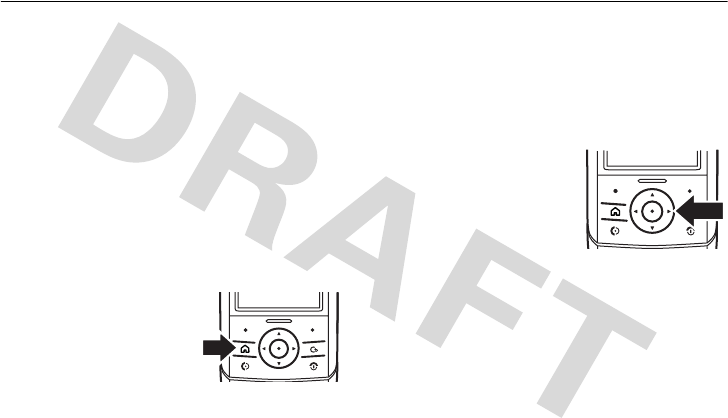
45
basics
basics
See page 1 for a basic phone diagram.
Tip:
Want some help? Press
Options
>
Help
within a feature, such as the Home screen.
Use the in-device help to find information
about main phone features.
basic navigation
home key
Press
g
to switch
between your Home
screen and the main
menu.
You can press
g
at
anytime to return to the main menu.
Tip:
Press and hold
g
to display a list of your
most recently used applications.
navigation key
Press the
navigation key
S
up,
down, left, or right to
scroll to items in the
display. When you
scroll to an item, press
the centre key
s
to select it.
tab scrolling
In some applications, such as Messaging,
Contacts, and Media Studio, you can press
the navigation key
S
left and right to scroll
between tabs.

46
basics
Home screen
The Home screen appears when you turn on
the phone, see page 24.
To dial a number from the Home screen, enter
a phone number and press
N
.
To “hang
up,”
close the slider or press
O
.
Press
S
up and down in the Home screen to
highlight plug-ins, then press the
centre key
s
to open the plug-in.
You can press
O
at anytime to return to the
the Home screen.
Soft Key Labels show the current soft key
functions. For soft key locations, see page 1.
Press
g
to switch between your Home
screen and the main menu.
main menu
Press
S
up, down, left, or right in the main
menu to highlight an application.
Press the centre key
s
to open the
application.
You can press
g
at anytime to return to the
main menu.
Soft Key Labels show the current soft key
functions. For soft key locations, see page 1.
Press
g
to switch between your Home
screen and the main menu.

47
basics
status indicators
Status indicators are displayed at the top of
the phone’s display:
1 Signal Strength Indicator –
Vertical bars
show the strength of the network
connection. Network services such as
calls may not be available when
1
or
0
appears.
2Network Indicator –
Shows when
your phone is using a GSM
connection (standard network access),
GPRS connection (high speed network
access), 3G connection (highest speed
network and video calling) or flight mode
(no network connection, see page 75).
3 Roam Indicator –
Shows when
your phone is seeking or using a
network outside your Home network.
5. Calls
4, 5, 6. Temporary Indicators
6. Message
7. Sound
Mode
8. Battery
Level
4. Bluetooth
3. Roam
2. Network
Indicator
1. Signal
Strength
Service Provider
12:00
Messages Camera
T
GSM
U
GPRS
f
3G
V
Flight mode
r
HSDPA

48
basics
4Bluetooth Indicator –
Shows current
Bluetooth status. Indicators may include:
5 Calls Indicator –
Shows various call
states. Indicators may include:
6 Message Indicator –
Shows when
you receive an SMS, MMS, email or
voicemail message. Indicators can
include:
7 Sound Mode Indicator –
Shows the
current sound mode.
8 Battery Level Indicator –
Vertical bars
show the battery charge level. Recharge
the battery when your display shows a
low battery.
X
Bluetooth on
(green)
X
Bluetooth
active (blue)
Y
sending
Z
active voice call
[
active video
call
\
missed call
]
SMS
^
email
_
MMS
a
voicemail
b
silent
d
speakerphone
c
microphone muted
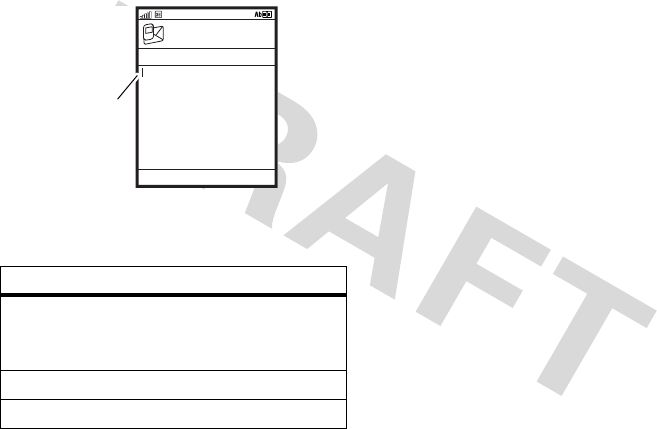
49
basics
text entry
Some features let you enter text.
Press
#
in a text entry view to select an
entry mode:
To set your preferred text entry mode, press
g> Control panel
>
Text Input Settings
.
iTAP™ and Multi-tap mode tips
•
Press
0
in a text entry view to
change text case to all capital letters
(
m
), no capitals (
k
), or next letter
capital (
i
).
•
Press
*
to enter a space at the cursor
and move on to the next word.
•
To enter numbers quickly, press and
hold a number key to temporarily
switch to numeric mode. Enter a space
to change back to iTAP or Multi-tap
mode.
•
Press
1
to enter punctuation or other
characters.
•
Press
S
to move the cursor.
entry modes
h
or
i
Your text entry mode can be set
to iTAP™ (
h
) predictive text or
Multi-tap
(
i
) mode.
nNumeric
mode enters numbers only.
oSymbol
mode enters symbols only.
SMS
OptionsSendCancel
0/1
To:
Flashing cursor
indicates insertion
point.
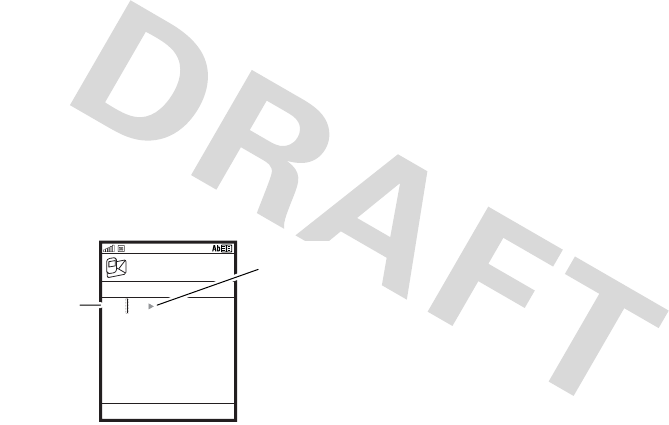
50
basics
•
Press
D
to delete the character to the
left of the cursor.
iTAP™ mode
Press
#
in a text entry view to switch to
iTAP
h
(predictive text) mode.
iTAP mode lets you enter words using one
keypress per letter. The iTAP software
combines your keypresses into common
words and predicts each word as you enter it.
For example, if you press
7764
,
your display shows:
If you want a different word (such as
Progress
),
continue pressing keypad keys to enter the
remaining letters.
If you want to select an alternative word press
S
up or down to scroll through the options.
Multi-tap mode
Press
#
in a text entry view to switch to
Multi-tap
i
mode.
To enter text in Multi-tap mode, press a
keypad key repeatedly to cycle through the
letters and number on the key. Repeat this
step to enter each letter.
SMS
OptionsSendCancel
0/1
To:
Prog ram
Press
S
right to accept
Program
.
Press
*
to
enter a space
at the cursor.
Press
S
up
or down to
scroll through
word options.
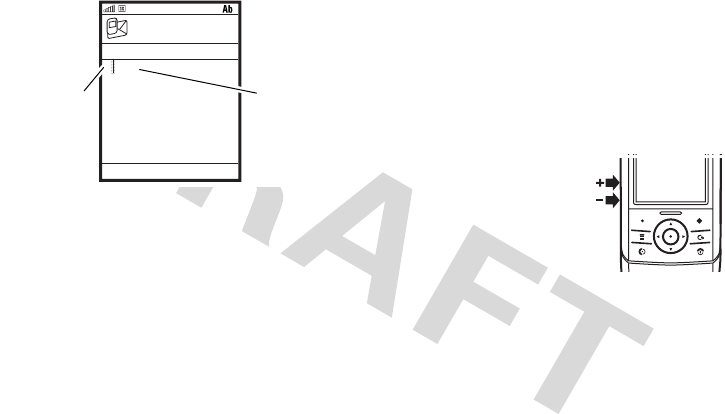
51
basics
For example, if you press
7
once, your
display shows:
numeric mode
Press
#
in a text entry view to switch to
numeric
n
mode. Press the number keys to
enter the numbers you want.
Shortcut:
You can press and hold a number
key to temporarily switch to numeric mode
from iTAP™ or Multi-tap modes. Enter a
space to change back to iTAP or Multi-tap
mode.
symbol mode
Press
#
in a text entry view until your
display shows a list of symbols. Scroll to the
symbol you want, then press the
centre key
s
.
volume
Press the volume keys to:
•
turn off an incoming
call alert
•
change the earpiece
volume during calls
•
change the music volume during music
playback
•
change the ringer volume from the
Home screen.
Note:
Changing the ringer volume will
update your current profile.
SMS
OptionsSendCancel
0/1
To:
Character
displays at
insertion
point.
After
2 seconds,
your phone
suggests a
word. Press
S
right to
accept it, or
press
*
to
enter a space
at the cursor.
P hone

52
basics
lock and unlock keypad
To lock your keypad with the slider closed
press and hold
O
until the power menu is
displayed. Select
Lock keypad
.
To unlock your keypad open the slider or press
any key and select
Yes
.
To lock your keypad with the slider open press
and hold
*
then select
Yes
.
To unlock your keypad press any key and
select
Yes
.
handsfree speaker
You can use your phone’s handsfree speaker
to make calls without holding the phone to
your ear.
To turn the handsfree speaker on during a call,
press the
Speaker
key (if available), or
Options
>
Audio
>
Speaker
.

53
customise
customise
profiles
Profiles define the look and sound of your
phone. Each profile uses a group of settings
to define items such as ring tones, message
alerts, screensavers and more. There are five
standard profiles
General
,
Indoor
,
Meeting
,
Outdoor
and
Silent
that you can edit or you can define
your own.
The current profile is displayed on your Home
screen if you have chosen to display the
profiles plug-in, see page 24.
Once you have defined your profiles, you can
swap between profiles to change the look and
sound of your phone.
To activate a profile:
Find it:
g
>
GControl panel
>
Profiles
>
profile name >
Activate
To edit a profile:
Find it:
g
>
GControl panel
>
Profiles
>
profile name >
Options
>
Edit
To create a new profile:
Find it:
g
>
GControl panel
>
Profiles
>
Options
>
New
> enter profile name

54
customise
changing ring style, volume,
and theme
You can change your ring style, volume, and
theme from the Basic tab.
Find it:
g
>
GControl Panel
>
Profiles:
profile
name >
Options
>
Edit
>
Basic
tab
changing voice call ring tones
You can change your voice call ring tones from
the Calls tab.
Find it:
g
>
GControl panel
>
Profiles:
profile
name >
Options
>
Edit
>
Calls
tab
changing message alerts
You can change your message alerts from the
Messages tab.
Find it:
g
>
GControl panel
>
Profiles:
profile
name >
Options
>
Edit
>
Messages
tab
changing other sounds
You can change other sounds from the
Sounds tab.
Find it:
g
>
GControl panel
>
Profiles:
profile
name >
Options
>
Edit
>
Sounds
tab
changing screen saver and
screen brightness
You can change your screen saver and screen
brightness from the Screen tab.
Find it:
g
>
GControl panel
>
Profiles:
profile
name >
Options
>
Edit
>
Screen
tab

55
customise
Home screen
You can change your Home screen settings.
changing plug-ins
You can change your plug-ins from the
Plug-ins tab.
Find it:
g
>
GControl panel
>
Home Settings
>
Plug-ins
>select plug-in
changing wallpaper
Set a photo or picture as a wallpaper
(background) image in your Home screen.
Find it:
g
>
GControl panel
>
Home Settings
>
Wallpaper
>
Choose
changing softkeys
You can change the function of your Home
screen’s right soft key.
Find it:
g
>
GControl panel
>
Home Settings
>
Soft Keys
managing themes
A phone theme is a group of image and
sound files that you can apply to your
phone. Most themes include a wallpaper
image, screen saver image, and ring tone.
Your phone may come with some themes,
and you can download more.
To
apply
a theme, use your profiles, see
page 53. Alternatively, press
g
>
GControl panel
>
Themes
, scroll to the
theme, and press
Options
>
Select
.
Note:
When you apply a theme, your current
profile will be updated.
To
download
a theme, see page 74.
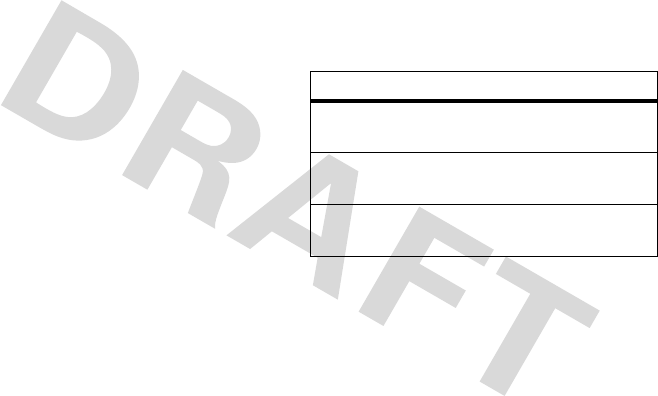
56
customise
To
delete themes you downloaded
, press
g
>
GControl panel
>
Themes
, scroll to the
theme, and press
Options
>
Delete
or
Delete All
.
To
view
a theme, press
g
>
GControl panel
>
Themes
, scroll to the theme, and
press
Options
>
View
.
time & date
To
manually
set the time and date, press
g
>
GControl panel
>
Device
>
Time & date
>date or time.
answer options
You can use different ways to answer an
incoming call:
Find it:
g
>
GControl panel
>
Call settings
options
Active Answer
Answer by opening the
slider.
Auto Answer
Answer automatically after
duration set in seconds.
Multi-key Answer
Answer by pressing any
key.

57
calls
calls
To make and answer calls, see page 22.
turn off a call alert
You can press the volume keys to turn off a
call alert before answering the call.
recent calls
Your phone keeps lists of incoming and
outgoing calls, even for calls that didn’t
connect. The most recent calls are listed first.
The oldest calls are deleted as new calls are
added. A record of
dialled numbers
,
answered calls
, and
missed calls
can be viewed in
the Recent Calls feature, and your missed
calls are also shown in the calls plug-in on the
Home screen (see page 24).
Find it:
g
>
BRecent calls
, then press left or
right to switch between tabs
All
,
Dialled
,
Missed
,or
Answered
.
Scroll to a call to see call details (like time and
date). To call the number, press
N
or the
centre key
s
.
return a call
1
Press
N
from the Home screen to see a
list of recently dialled calls.
2
Press left or right to scroll to the missed
calls tab.
3
Scroll to the call you want to return, then press
N
.
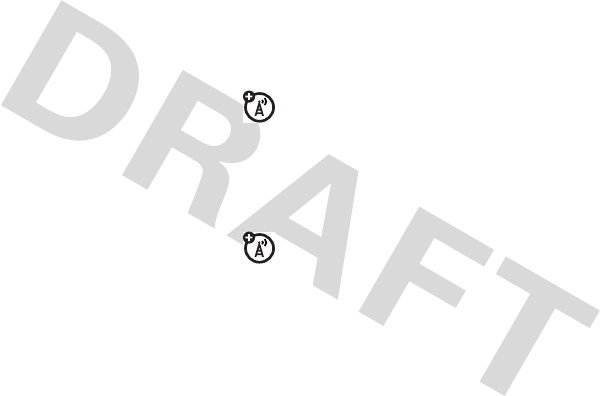
58
calls
redial
1
Press
N
from the Home screen to see a
list of recently dialled calls.
2
Scroll to the entry you want to call, then
press
N
.
If you hear a
busy signal
, and you see
Call Failed
, you can press
N
or the
Retry
key to redial the number.
caller ID
Calling line identification (caller ID)
shows the phone number for an
incoming call on your display.
Your phone shows the caller’s name and
picture when they’re stored in your contacts,
or
Incoming Call
when caller ID information isn’t
available.
You can set your phone to play a different ring
tone for an entry stored in your contacts (see
page 64).
To show or hide
your phone number
from
the next person you call, enter the phone
number and press
Options
>
Hide my ID
/
Show my ID
.
emergency calls
Your service provider programs one or more
emergency phone numbers, such as 999, that
you can call under any circumstances, even
when your phone is locked or the SIM card is
not inserted.
Note:
Emergency numbers vary by country.
Your phone’s preprogrammed emergency
number(s) may not work in all locations, and
sometimes an emergency call cannot be
placed due to network, environmental, or
interference issues.

59
calls
1
Press the keypad keys to dial the
emergency number.
2
Press
N
to call the emergency number.
voicemail
Your network stores the voicemail
messages you receive. To listen to your
messages, press and hold
1
from the Home
screen.
Note:
Your service provider may include
additional information about using this
feature.
When you
receive
a voicemail message, your
phone shows the voicemail message
indicator
a
and
New voicemail
. Press the
Call
key to listen to the message.
To
check
voicemail messages:
Find it:
Press and hold
1
from the Home
screen, or press
g
>
GControl panel
>
Voicemail
Your phone may prompt you to store your
voicemail phone number. If you don’t know
your voicemail number, contact your service
provider.
Note:
You can’t store a
p
(pause),
w
(wait), or
n
(number) character in this number. If you want
to store a voicemail number with these
characters, create a contacts entry for it. Then
you can use the entry to call your voicemail.
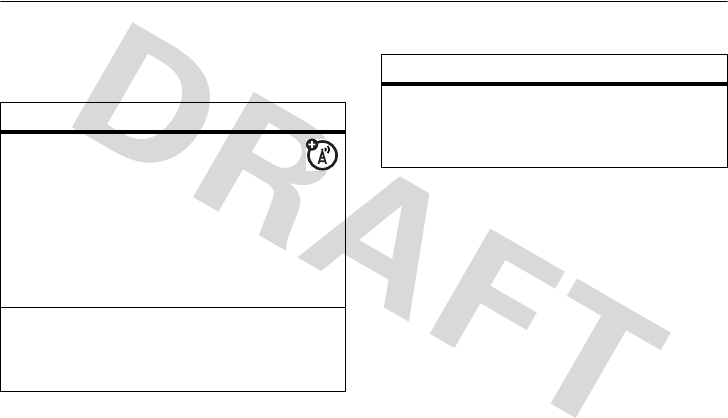
60
other features
other features
advanced calling
features
international calls
If your phone service includes
international dialling, press and hold
0
to
insert your local international access code
(indicated by
+
). Then, press the keypad
keys to dial the country code and phone
number.
hold a call
Press
Options
>
Hold
to put all active calls on
hold.
mute a call
Press the
Mute
key (if available) or
Options
>
Mute
to put all active calls on mute.
features
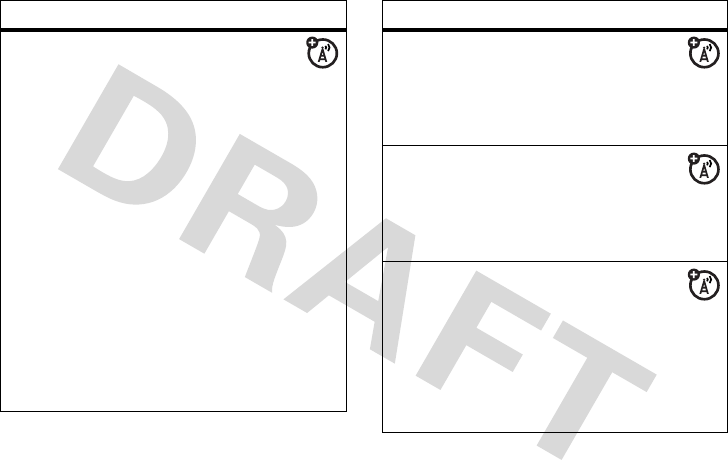
other features—advanced calling
61
call waiting
When you’re on a call, you’ll hear an
alert if you receive a second call.
Press
N
to answer the new call.
•
To switch between calls, press the
Answer
key.
•
To connect the calls in a conference
call, press
Options
>
Link calls
.
•
To end the call on hold, press
Options
>
End Call On Hold
.
To turn the call waiting feature on or off,
press
g
>
GControl panel
>
Call settings
>
Call
waiting
>
Voice call waiting
or
Video call waiting
>
Mark
or
Unmark
.
features
conference call
During a call:
Dial the next number, press
N
, and press
Options
>
Link calls
.
transfer a call
During a call:
Options
>
Transfer
, dial transfer number,
press
N
.
call divert
Set up or cancel call divert:
g
>
GControl panel
>
Call settings
>
Call diverting
Choose
Voice
,
Video
,
Fax
, or
Data
and then
select which type of calls to forward and
the phone number to forward the calls to.
features
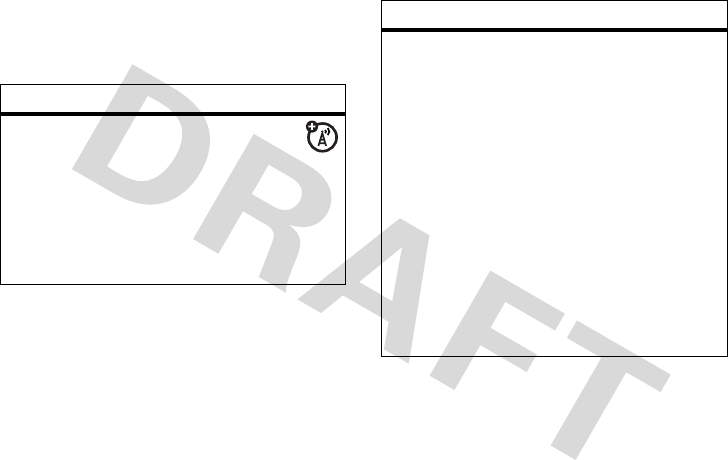
62
other features—restrict calls and messages
restrict calls and
messages
features
call barring
Restrict outgoing or incoming calls:
Restrict your voice or video calls to block all
calls, international calls, or all calls except
ones on your home network.
g
>
GControl Panel
>
Call settings
>
Call barring
Block calls and text messages
You can add phone numbers and email
addresses to your block lists. The block list
stops all calls, text messages and emails
from a number or email address.
To activate your block list:
g
>
GControl panel
>
Kill filter
>
Block list
tab
>
Enable
To add a number or email address to your
block list:
g
>
GControl panel
>
Kill filter
>
Block list
tab
>
Add
features
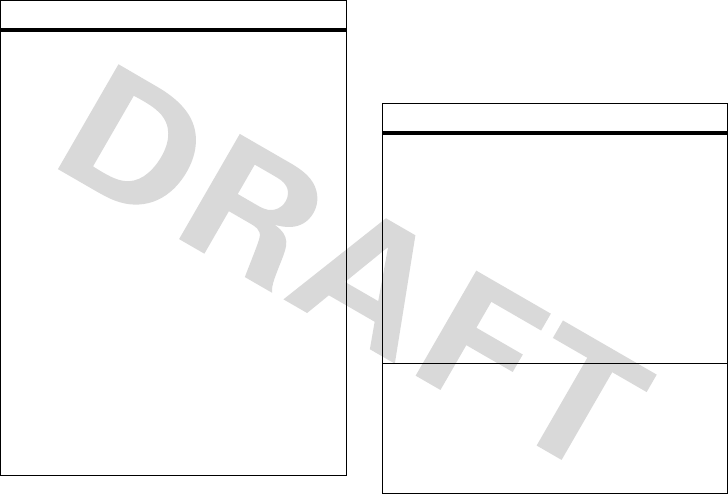
other features—contacts
63
contacts
To store and call contacts entries, see
page 22.
Allow calls
You can add phone numbers from your
contacts to your allow lists. An activated
allow list only allows calls from the phone
numbers in your contacts that you have
added to that allow list. You can have a
number of allow lists.
To activate your allow list:
g
>
GControl panel
>
Kill filter
>
Allow list
tab
> select allow list >
Activate
To add a number to your allow list:
g
>
GControl panel
>
Kill filter
>
Allow list
tab
>
New
To associate your allow list with a profile:
g
>
GControl panel
>
Profiles:
profile name >
Options
>
Edit
>
Calls
tab >
Kill filter allow list
features
features
assign a speed dial key to a contacts
entry
You can assign the keys
2
through
9
to
contacts entries. Then, when you press and
hold a key from the Home screen, you can
make a voice call, video call or send a
message to the contact.
Press
g
>
GControl panel
>
Speed Dial
and
assign a key.
use the speed dial key for a contacts
entry
To
use a speed dial key
that you assigned
to a contacts entry, just press and hold the
key from the Home screen.
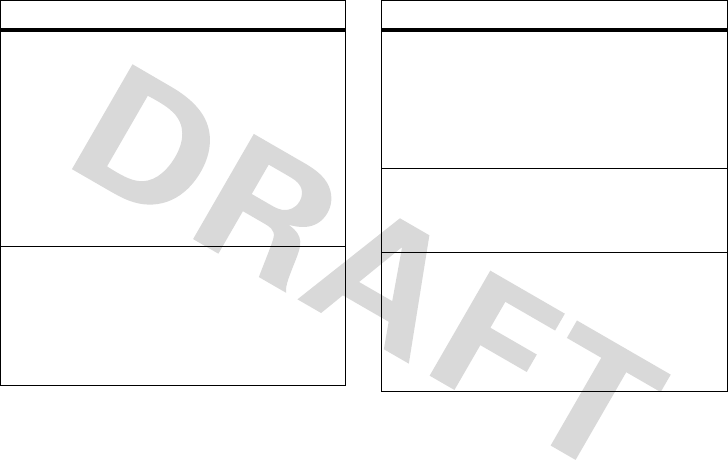
64
other features—contacts
edit or delete a contacts entry
Edit a number stored in the contacts:
g
>
AContacts
, scroll to the contacts entry,
and press
Options
. You can select
Edit contact
,
Delete
, or other options.
Shortcut:
In the contacts, press keypad
keys to enter the first letters of an entry you
want.
set ring tone for a contacts entry
Assign a ring tone to an entry:
g
>
AContacts
> entry, then press
Options
>
Edit contact
>
Ring tone
>ring tone name
features
set image for a contacts entry
Assign a photo or picture to show when you
receive a call from an entry:
g
>
AContacts
> entry, then press
Options
>
Edit contact
>
Image
> image name
set category for a contacts entry
g
>
AContacts
> entry, then press
Options
>
Edit contact
>
Category
> category name
set category view for contacts
g
>
AContacts
, then press
Options
>
View
category
>category name
You can show
All phone contacts
entries in a
category you create.
features
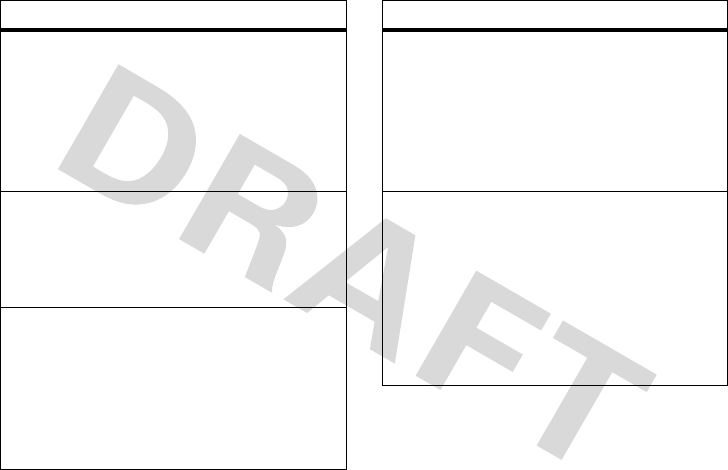
other features—contacts
65
create group mailing list
You can put several contacts entries in a
group mailing list, then send a message to
the list. To create a list:
g
>
AContacts
, then press
Options
>
New group
sort contacts list
Set the order in which entries are listed:
g
>
AContacts
, then press
Options
>
Settings
>
Sort by
copy one contacts entry
Copy an entry from the phone to the SIM
card, or from the SIM card to the phone
contacts:
g
>
AContacts
, scroll to the entry, press
Options
>
Add to
>
SIM
or
Options
>
Copy to Contacts
features
copy multiple contacts entries
Copy multiple contacts entries between the
phone and SIM card:
g
>
AContacts
, then press
Options
>
Marking
>
Mark
or
Mark all
and then
Options
>
Add to
>
SIM
or
Options
>
Copy to Contacts
send contacts entry to another device
Send a contacts entry to another phone,
computer, or device:
g
>
AContacts
, scroll to the entry, press
Options
>
Send as
For more information about sending files via
Bluetooth, see page 39.
features
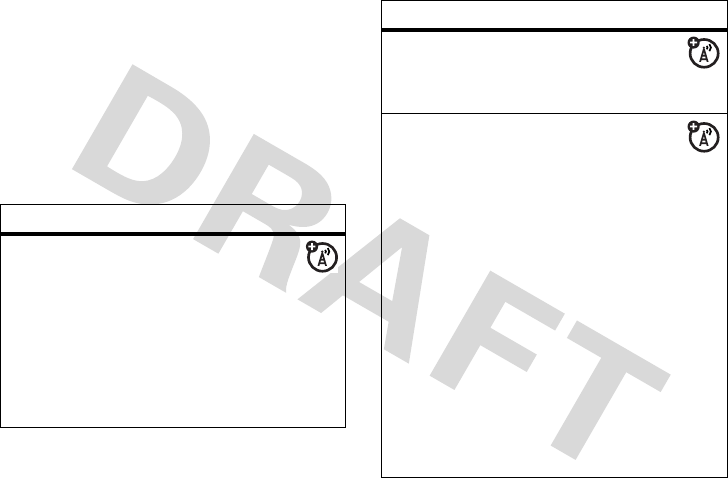
66
other features—messaging
messaging
For basic messaging features, see page 25.
Your phone reads message settings from the
SIM card. If you put another SIM card in your
phone, your phone sends and receives
messages for the phone number on the new
card.
features
send voice message
g
>
EMessaging
>
Create new message
>
MMS
or
Email
>
Options
>
Add
>
Record sound
Press the centre key
s
to start and stop
recording.
Your phone inserts the voice recording into
the message.
save a message as a template
g
>
EMessaging
>
Create new message
>
SMS
or
MMS
or
Email
>
Options
>
Save as template
read and manage messages
g
>
EMessaging
>
Messages Inbox
Icons next to each message indicate if it is
read
>
or unread
<
. Icons can also
indicate if the message has an
attachment
=
, or is high priority (red), or low
priority (blue).
To
Reply
,
Forward
, or
Delete message
, scroll to the
message and press
Options
.
To open a message, press the
centre key
s
. Then, you can press
Options
to use or store any phone numbers,
email addresses, Web sites, or files in the
message.
features
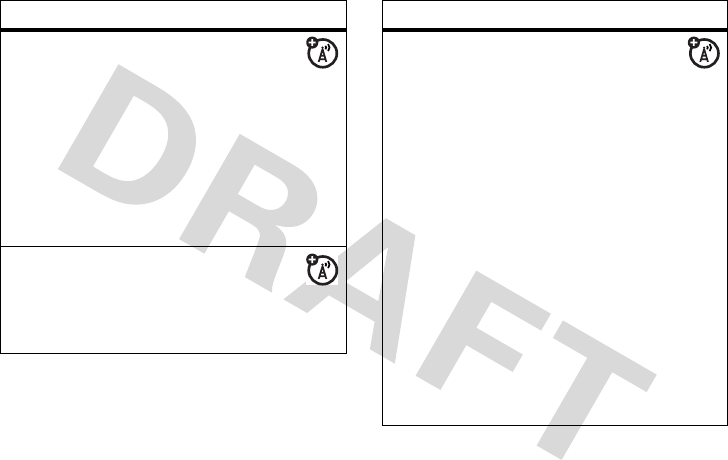
other features—messaging
67
read and manage email
g
>
EMessaging
>
Email Inbox
To
Reply
,
Forward
, or
Delete
an email, scroll to it
and press
Options
.
To open an email, press the centre key
s
.
Then, you can press
Options
to use or store
any phone numbers, email addresses,
Web sites, or files in the message.
store message objects
Go to a multimedia message, or scroll
to an object in a message, then press
Options
>
Store
.
features
edit email settings
You can edit the settings for your
email connections. To use email, you need
to store your email
Account name
and details.
g
>
EMessaging
, then press
Options
>
Settings
>
Email accounts
If you have more than one email account,
select an account to edit.
Your phone shows a list of email settings.
Here is where you store your email
Account
name
and details.
Note:
To create a new account, select
Options
>
New
in the
Email accounts
list. Your
display shows a folder for each email
account under
s
>
Messaging
>
Email Inbox
.
features
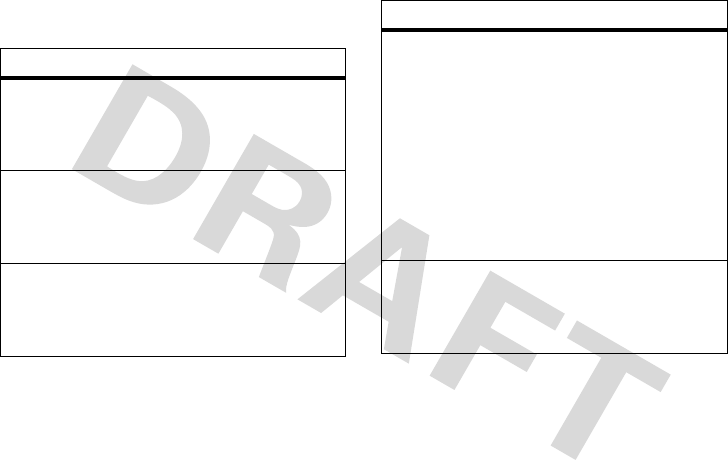
68
other features—device settings
device settings
call times & costs
Network connection time
is the elapsed
time from the moment you connect to your
service provider's network to the moment
features
location
Set time zone location:
g
>
GControl panel
>
Device
>
Location
number formats
Set number formats:
g
>
GControl panel
>
Device
>
Number formats
language
Set menu language:
g
>
GControl panel
>
Device
>
Select language
master reset
Caution:
Master reset can
erase all
information you have entered
(including
contacts and calendar entries)
and content
you have downloaded
(including
applications, photos, and sounds) stored in
your phone’s memory. After you erase the
information, you can’t recover it.
g
>
GControl panel
>
Device
>
Master Reset
storage wizard
View and free up memory storage.
g
>
ITools
>
Storage wizard
features
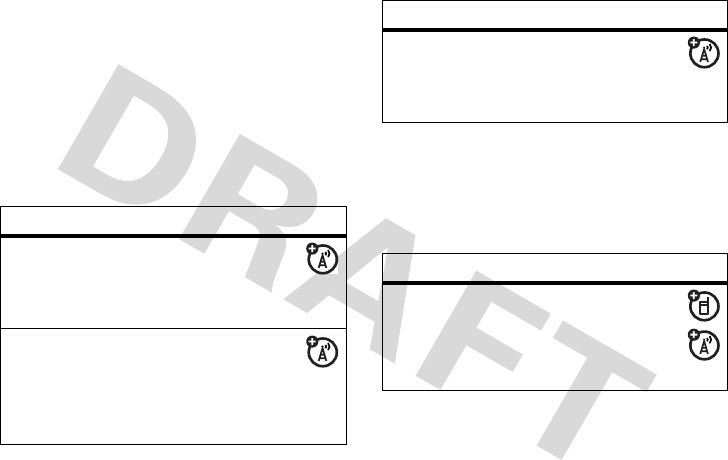
other features—data calls
69
you end the call by pressing
O
. This time
includes busy signals and ringing.
The amount of network connection time
you track on your resettable timer may not
equal the amount of time for which you
are billed by your service provider. For
billing information, contact your service
provider.
data calls
To connect your phone with a USB cable, see
page 42.
features
call times
Show call timers:
g
>
GControl panel
>
Call settings
>
Call Timers
in-call timer
Show time or cost information during
a call:
g
>
GControl panel
>
Call settings
>
In Call Timer
call charges
Show call charges trackers:
g
>
GControl panel
>
Call settings
>
Call Charges
features
send data
Connect your phone to the device,
then place the call through the device
application.
features

70
other features—network
network
receive data
Connect your phone to the device,
then answer the call through the
device application.
set up Remote Sync
You can use the Internet to
synchronise your phone’s contacts
and calendar entries with an email
account on a Microsoft® Exchange 2003
Server.
You need to know the email account’s
user
name
and
password
, the Microsoft®
Exchange
server name
, and the
user
domain name
. Confirm that the
Mobility
option is enabled on the email account, and
that
data service
is activated with your
phone service provider.
features
use Remote Sync
Once you set up an Remote Sync
partner, you can schedule your phone
to synchronise with the account
automatically.
To schedule synchronization, press
g
>
CConnectivity
>
Remote sync
features
network settings
See network information and adjust
network settings:
g
>
GControl panel
>
Network settings
features
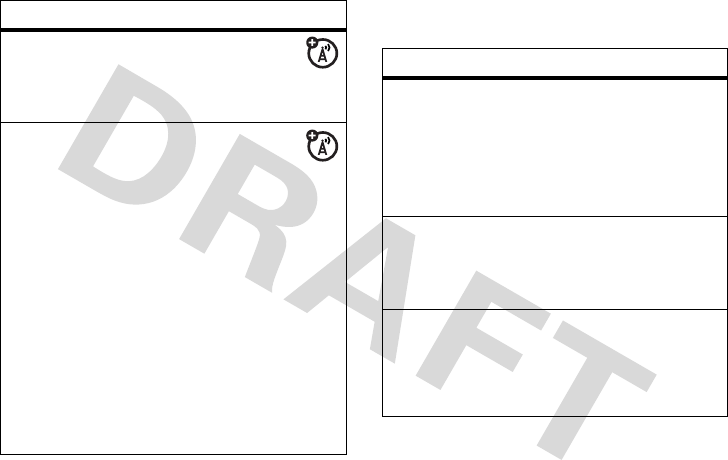
other features—calendar
71
calendar
cell broadcast
To send a cell broadcast message:
g
>
GControl panel
>
Cell broadcast settings
device update
Your service provider can send
updated phone software over the air to your
phone. When your phone receives a
software update, you can choose to
download it and install it later. To install a
software update you downloaded:
g
>
GControl panel
>
Device
>
Device management
Note:
You may want to copy your data to
your memory card (see page 77) or
computer (see page 42) to ensure no data
is lost.
features
features
add new calendar event
Your calendar can store events (
Appointment
,
Reminder
,
All day event
and
Anniversary
).
g
>
D Calendar
, scroll to the day, press
s
,
press
Options
>
New
see calendar event
See or edit event details:
g
>
DCalendar
, scroll to the day, press
s
event reminder
When an event reminder happens:
To see reminder details, press the
View
key.
To close the reminder, press the
Back
key.
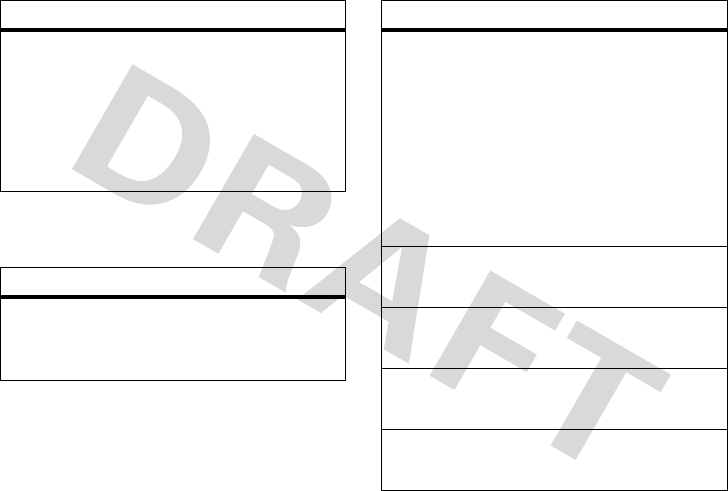
72
other features—tools
tools
send calendar event to another device
Send a calendar event to another phone,
computer, or device:
g
>
DCalendar
, scroll to the day, press
s
,
scroll to the event, press
Options
>
Send this
category
features
set alarm
g
>
ITools
>
Time
>
Wake up!
or >
Lunchtime
or >
Early night
, >
Options
>
Edit
features
turn off alarm
When an alarm happens:
To turn off the alarm, press the
Done
key or
O
.
To set a delay, press the
Snooze
key.
Note:
The
Snooze
key is available only if the
phone is already powered on when the
alarm sounds.
to do
g
>
ITools
>
To Do
calculator
g
>
ITools
>
Calculator
jotter
g
>
ITools
>
Jotter
file manager
g
>
ITools
>
File manager
features
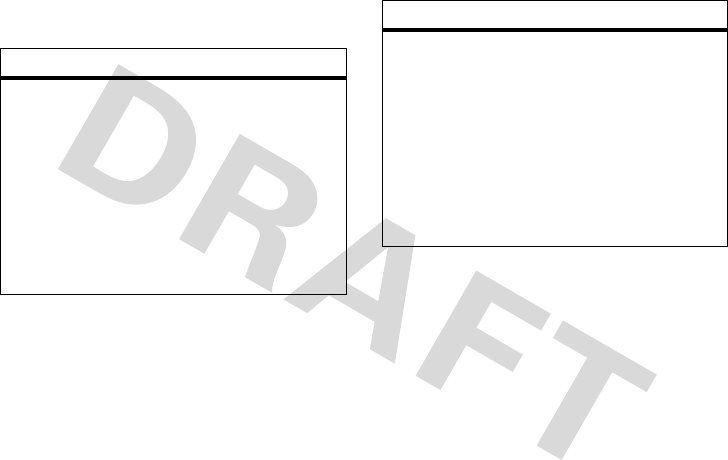
other features—security
73
security
features
SIM PIN
Caution:
If you enter an incorrect PIN code
three times before the correct code, your
SIM card is disabled and your display shows
SIM Blocked
.
Lock or unlock the SIM card and/or change
PIN1 and PIN2 codes:
g
>
GControl panel
>
Security
>
SIM PIN
Manage certificates
Enable or disable Internet access or Java™
certificates stored on your phone:
g
>
GControl panel
>
Security
>
Certificate manager
or
g
>
GControl panel
>
Security
>
Java certificates
features
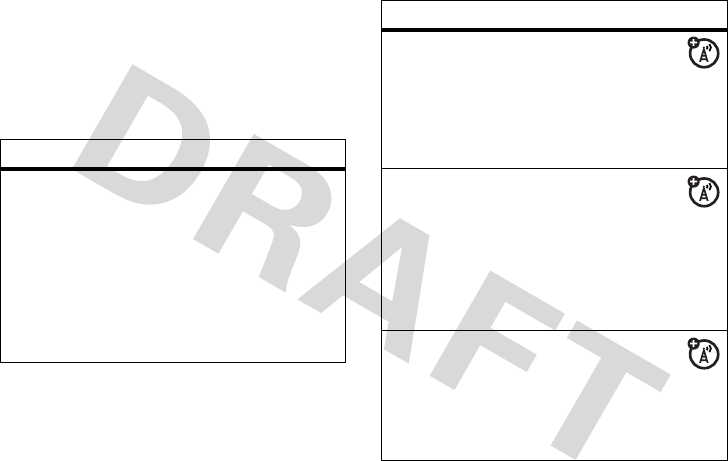
74
other features—pictures, videos and games
pictures, videos and
games
For basic information on the camera, see
page 28.
features
view, delete, or manage multi media files
Manage photos, pictures, animations,
videos, ring tones, sounds and music:
g
>
FMedia Studio
>
Media Gallery
> tab
To view a file, scroll to it in the list and press
the centre key
s
. To
delete
a file and for
other options, press
Options
.
download objects from Web page
Download a picture, sound, or other
object from a Web page:
g
>
qWeb
, go to the page that links to
the file, scroll to the link, and select it.
download game or application
You can download a Java™ game or
application the same way you download
pictures or other objects:
g
>
qWeb
, go to the page that links to
the file, scroll to the link, and select it.
install or uninstall
To install or uninstall an application,
simply scroll to the application in
g
>
GControl panel
>
Install
or
Uninstall
and
press the centre key
s
.
features
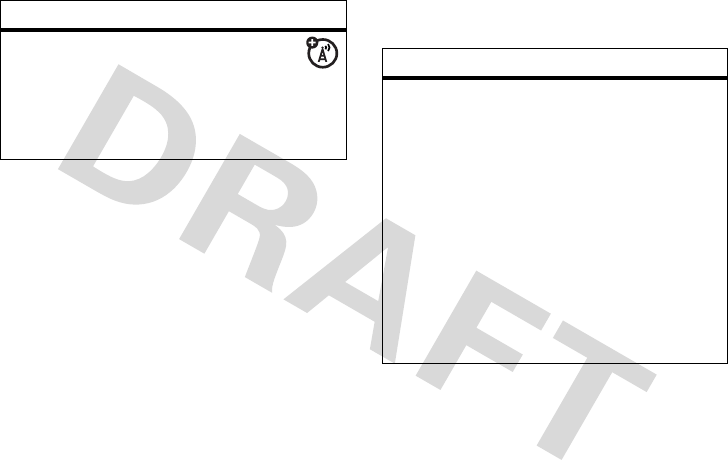
other features—flight mode
75
flight mode
start game or application
To start a Java™ game or application,
simply scroll to the game or application in
the main menu or
LGames
and press the
centre key
s
.
features
features
flight mode
You can switch your phone to flight mode to
prevent it from communicating with the
network. This lets you play music, games or
other applications while you are on an
airplane, without interfering with airplane
communications.
Note:
Your phone cannot make Bluetooth™
connections when
Flight Mode
is on.
Press and hold
O
until the power menu is
displayed and select
Flight Mode
.
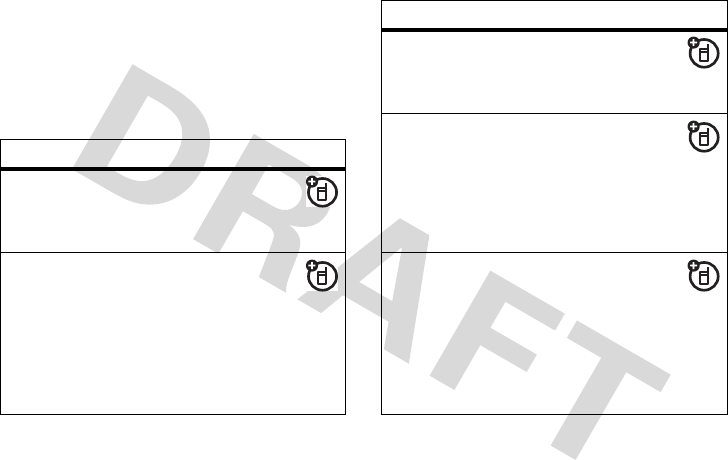
76
other features—advanced Bluetooth features
advanced Bluetooth
features
A device is recognised after you connect to it
once (see page 37).
features
change your phone’s name
g
>
CConnectivity
>
Bluetooth
>
My phone name
make phone visible to other
devices
Allow a Bluetooth device to discover your
phone:
g
>
CConnectivity
>
Bluetooth
>
Visible to other
devices
enable power saving
g
>
CConnectivity
>
Bluetooth
>
Enable power saving
connect to recognised device
Connect your phone to a recognised
device:
g
>
CConnectivity
>
Bluetooth
>
My devices
>device name
disconnect a headset or handsfree
device
g
>
CConnectivity
>
Bluetooth
>
Enabled audio devices
Scroll to the device name and press
Options
>
Disconnect
.
features
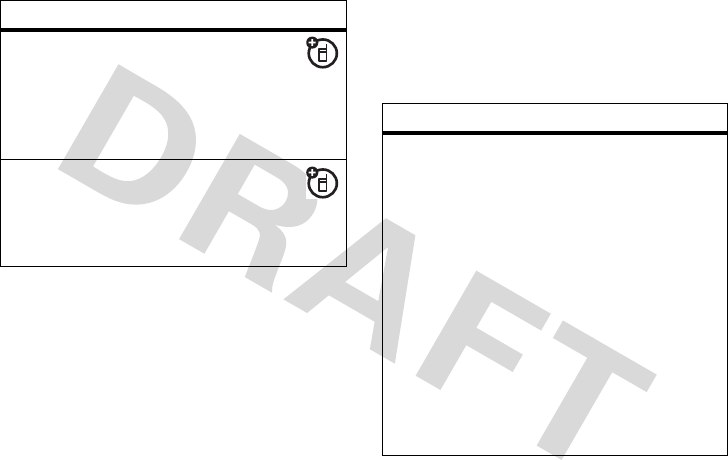
other features—memory card
77
memory card
For basic information on the memory card,
see page 20.
switch to headset or handsfree
device during call
During a call, press
Options
>
Audio
>device name, to switch to a recognised
headset or car kit.
copy multimedia object to device
Scroll to the object, press
Options
>
Send as
>
Bluetooth
, select the device name.
You cannot copy some copyrighted files.
features
features
see and change memory card
information
To see the files stored on your memory card
and on your phone, open a file list, such as
g
>
ITools
>
File manager
press left or right
key to select the phone or memory card tab
and press up or down key to select a folder.
To copy or move a file from your phone to
your memory card, highlight it in the list and
press
Options
>
Edit
>
Copy to
or
Move to
>
Memory card
tab > folder
Options
>
Copy
or
Move
.
You cannot copy or move some copyrighted
files.
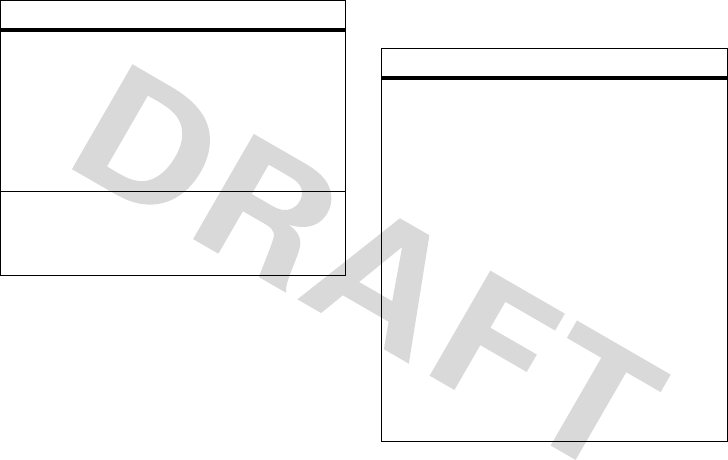
78
other features—protected content
protected content
memory card name, available memory
and other information
To see your
memory card name, available
memory,
and other information about the
card:
g
>
GControl panel
>
Device
>
Storage Wizard
rename memory card
g
>
ITools
>
File manager
>
Memory card
tab,
s
>
Options
>
Edit
>
Rename
features
features
store and use protected content
If you try to play a copyrighted file, it might
ask you to download a license. Some
licenses only let you play a file for a certain
number of times or days.
For example, a license may allow you to
play the content of your download five
times or use the content for three days
before it expires.
You cannot send, copy, or change
copyrighted files.
To download a file, see page 74. To activate
downloaded copyrighted files, simply open
the file.

Recycling Information
79
service and repairs
If you have questions or need assistance,
we're here to help.
Go to
www.motorola.com/consumer/support
,
where you can select from a number of
customer care options. You can also contact
the Motorola Customer Support centre at
1-800-331-6456 (United States),
1-888-390-6456 (TTY/TDD United States for
hearing impaired), or 1-800-461-4575
(Canada).

80
SAR Data
Specific Absorption Rate Data
SAR Da ta
This model meets international guidelines for
exposure to radio waves.
Your mobile device is a radio transmitter and receiver. It is
designed not to exceed the limits for exposure to radio waves
recommended by international guidelines. These guidelines were
developed by the independent scientific organization ICNIRP and
include safety margins designed to assure the protection of all
persons, regardless of age and health.
The guidelines use a unit of measurement known as the Specific
Absorption Rate, or SAR. The ICNIRP SAR limit for mobiles devices
used by the general public is 2 W/kg and the highest SAR value for
this device when tested at the ear was ___ W/kg.
1
As mobile
devices offer a range of functions, they can be used in other
positions, such as on the body as described in this user guide.
2
In
this case, the highest tested SAR value is ___ W/kg.
1
As SAR is measured utilizing the device’s highest transmitting
power, the actual SAR of this device while operating is typically
below that indicated above. This is due to automatic changes to
the power level of the device to ensure it only uses the minimum
level required to reach the network.
While there may be differences between the SAR levels of various
phones and at various positions, they all meet the governmental
requirements for safe exposure. Please note that improvements to
this product model could cause differences in the SAR value for
later products; in all cases, products are designed to be within the
guidelines.
The World Health Organization has stated that present scientific
information does not indicate the need for any special precautions
for the use of mobile devices. They note that if you want to reduce
your exposure then you can do so by limiting the length of calls or
using a “hands-free” device to keep the mobile phone away from
the head and body.
Additional Information can be found on the websites of the World
Health Organization (
http://www.who.int/emf
) or
Motorola, Inc.
(
http://www.motorola.com/rfhealth
).
1. The tests are carried out in accordance with international guidelines for
testing. The limit incorporates a substantial margin for safety to give
additional protection for the public and to account for any variations in
measurements. Additional related information includes the Motorola
testing protocol, assessment procedure, and measurement uncertainty
range for this product.
2. Please see the Safety and General Information section about body worn
operation.

SAR Data
Specific Absorption Rate Data
SAR Da ta
This model wireless phone meets the
government’s requirements for exposure to radio
waves.
Your wireless phone is a radio transmitter and receiver. It is
designed and manufactured not to exceed limits for exposure to
radio frequency (RF) energy set by the Federal Communications
Commission (FCC) of the U.S. Government and by the Canadian
regulatory authorities. These limits are part of comprehensive
guidelines and establish permitted levels of RF energy for the
general population. The guidelines are based on standards that
were developed by independent scientific organizations through
periodic and thorough evaluation of scientific studies. The
standards include a substantial safety margin designed to assure
the safety of all persons, regardless of age or health.
The exposure standard for wireless mobile phones employs a unit
of measurement known as the Specific Absorption Rate, or SAR.
The SAR limit set by the FCC and by the Canadian regulatory
authorities is 1.6 W/kg.
1
Tests for SAR are conducted using
standard operating positions accepted by the FCC and by Industry
Canada with the phone transmitting at its highest certified power
level in all tested frequency bands. Although the SAR is
determined at the highest certified power level, the actual SAR
level of the phone while operating can be well below the
maximum value. This is because the phone is designed to operate
at multiple power levels so as to use only the power required to
reach the network. In general, the closer you are to a wireless
base station, the lower the power output.
Before a phone model is available for sale to the public in the U.S.
and Canada, it must be tested and certified to the FCC and Industry
Canada that it does not exceed the limit established by each
government for safe exposure. The tests are performed in
positions and locations (e.g., at the ear and worn on the body)
reported to the FCC and available for review by Industry Canada.
The highest SAR value for this model phone when tested for use at
the ear is 0.91 W/kg, and when worn on the body, as described in
this user guide, is 0.58 W/kg.
(Body-worn
measurements differ among phone models, depending upon
available accessories and regulatory requirements).
2
While there may be differences between the SAR levels of various
phones and at various positions, they all meet the governmental
requirements for safe exposure. Please note that improvements to
this product model could cause differences in the SAR value for
later products; in all cases, products are designed to be within the
guidelines.

SAR Data
Additional information on Specific Absorption Rates (SAR) can be
found on the Cellular Telecommunications & Internet Association
(CTIA) Web site:
http://www.phonefacts.net
or the Canadian Wireless Telecommunications Association (CWTA)
Web site:
http://www.cwta.ca
1. In the United States and Canada, the SAR limit for mobile phones used
by the public is 1.6 watts/kg (W/kg) averaged over one gram of tissue.
The standard incorporates a substantial margin of safety to give
additional protection for the public and to account for any variations in
measurements.
2. The SAR information includes the Motorola testing protocol,
assessment procedure, and measurement uncertainty range for this
product.
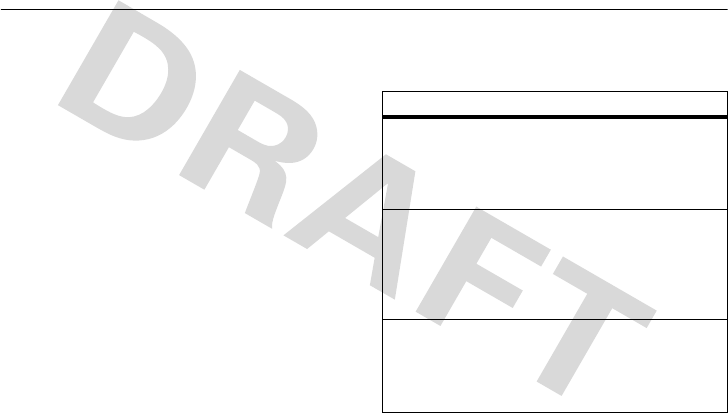
Warranty
81
Motorola Limited Warranty for the United States and
Canada
Warranty
What Does this Warranty Cover?
Subject to the exclusions contained below, Motorola, Inc. warrants
its telephones, pagers, messaging devices, and consumer and
professional two-way radios (excluding commercial, government
or industrial radios) that operate via Family Radio Service or
General Mobile Radio Service, Motorola-branded or certified
accessories sold for use with these Products (“Accessories”) and
Motorola software contained on CD-ROMs or other tangible media
and sold for use with these Products (“Software”) to be free from
defects in materials and workmanship under normal consumer
usage for the period(s) outlined below. This limited warranty is a
consumer's exclusive remedy, and applies as follows to new
Motorola Products, Accessories and Software purchased by
consumers in the United States or Canada, which are accompanied
by this written warranty:
Products and Accessories
Products Covered Length of Coverage
Products and
Accessories
as
defined above, unless
otherwise provided for
below.
One (1) year
from the date of
purchase by the first consumer
purchaser of the product unless
otherwise provided for below.
Decorative
Accessories and
Cases.
Decorative
covers, bezels,
PhoneWrap™ covers
and cases.
Limited lifetime warranty
for the
lifetime of ownership by the first
consumer purchaser of the product.
Monaural Headsets.
Ear buds and boom
headsets that transmit
mono sound through a
wired connection.
Limited lifetime warranty
for the
lifetime of ownership by the first
consumer purchaser of the product.
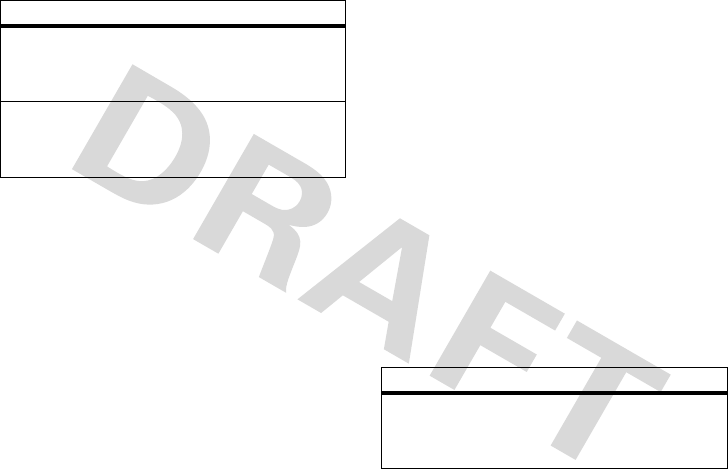
82
Warranty
Exclusions
Normal Wear and Tear.
Periodic maintenance, repair and
replacement of parts due to normal wear and tear are excluded
from coverage.
Batteries.
Only batteries whose fully charged capacity falls below
80% of their rated capacity and batteries that leak are covered by
this limited warranty.
Abuse & Misuse.
Defects or damage that result from:
(a) improper operation, storage, misuse or abuse, accident or
neglect, such as physical damage (cracks, scratches, etc.) to the
surface of the product resulting from misuse; (b) contact with
liquid, water, rain, extreme humidity or heavy perspiration, sand,
dirt or the like, extreme heat, or food; (c) use of the Products or
Accessories for commercial purposes or subjecting the Product or
Accessory to abnormal usage or conditions; or (d) other acts which
are not the fault of Motorola, are excluded from coverage.
Use of Non-Motorola Products and Accessories.
Defects or
damage that result from the use of Non-Motorola branded or
certified Products, Accessories, Software or other peripheral
equipment are excluded from coverage.
Unauthorised Service or Modification.
Defects or damages
resulting from service, testing, adjustment, installation,
maintenance, alteration, or modification in any way by someone
other than Motorola, or its authorised service centres, are
excluded from coverage.
Altered Products.
Products or Accessories with (a) serial
numbers or date tags that have been removed, altered or
obliterated; (b) broken seals or that show evidence of tampering;
(c) mismatched board serial numbers; or (d) nonconforming or
non-Motorola housings, or parts, are excluded from coverage.
Communication Services.
Defects, damages, or the failure of
Products, Accessories or Software due to any communication
service or signal you may subscribe to or use with the Products
Accessories or Software is excluded from coverage.
Software
Consumer and
Professional
Two-Way Radio
Accessories.
Ninety (90) days
from the date of
purchase by the first consumer
purchaser of the product.
Products and
Accessories that are
Repaired or
Replaced.
The balance of the original
warranty or for ninety (90) days
from the date returned to the
consumer, whichever is longer.
Products Covered Length of Coverage
Products Covered Length of Coverage
Software.
Applies only to physical
defects in the media that embodies
the copy of the software (e.g.
CD-ROM, or floppy disk).
Ninety (90) days
from
the date of purchase.

Warranty
83
Exclusions
Software Embodied in Physical Media.
No warranty is made
that the software will meet your requirements or will work in
combination with any hardware or software applications provided
by third parties, that the operation of the software products will be
uninterrupted or error free, or that all defects in the software
products will be corrected.
Software NOT Embodied in Physical Media.
Software that is
not embodied in physical media (e.g. software that is downloaded
from the internet), is provided “as is” and without warranty.
Who Is Covered?
This warranty extends only to the first consumer purchaser, and is
not transferable.
What Will Motorola Do?
Motorola, at its option, will at no charge repair, replace or refund
the purchase price of any Products, Accessories or Software that
does not conform to this warranty. We may use functionally
equivalent reconditioned/refurbished/pre-owned or new Products,
Accessories or parts. No data, software or applications added to
your Product, Accessory or Software, including but not limited to
personal contacts, games and ringer tones, will be reinstalled. To
avoid losing such data, software and applications please create a
back up prior to requesting service.
How to Obtain Warranty Service or
Other Information
You will receive instructions on how to ship the Products,
Accessories or Software, at your expense, to a Motorola
Authorised Repair centre. To obtain service, you must include: (a) a
copy of your receipt, bill of sale or other comparable proof of
purchase; (b) a written description of the problem; (c) the name of
your service provider, if applicable; (d) the name and location of the
installation facility (if applicable) and, most importantly; (e) your
address and telephone number.
USA Phones
1-800-331-6456
Pagers
1-800-548-9954
Two-Way Radios and Messaging Devices
1-800-353-2729
Canada All Products
1-800-461-4575
TTY
1-888-390-6456
For
Accessories
and
Software
, please call the telephone
number designated above for the product with which they are
used.

84
Warranty
What Other Limitations Are There?
ANY IMPLIED WARRANTIES, INCLUDING WITHOUT LIMITATION
THE IMPLIED WARRANTIES OF MERCHANTABILITY AND FITNESS
FOR A PARTICULAR PURPOSE, SHALL BE LIMITED TO THE
DURATION OF THIS LIMITED WARRANTY, OTHERWISE THE
REPAIR, REPLACEMENT, OR REFUND AS PROVIDED UNDER THIS
EXPRESS LIMITED WARRANTY IS THE EXCLUSIVE REMEDY OF
THE CONSUMER, AND IS PROVIDED IN LIEU OF ALL OTHER
WARRANTIES, EXPRESS OR IMPLIED. IN NO EVENT SHALL
MOTOROLA BE LIABLE, WHETHER IN CONTRACT OR TORT
(INCLUDING NEGLIGENCE) FOR DAMAGES IN EXCESS OF THE
PURCHASE PRICE OF THE PRODUCT, ACCESSORY OR SOFTWARE,
OR FOR ANY INDIRECT, INCIDENTAL, SPECIAL OR
CONSEQUENTIAL DAMAGES OF ANY KIND, OR LOSS OF
REVENUE OR PROFITS, LOSS OF BUSINESS, LOSS OF
INFORMATION OR DATA, SOFTWARE OR APPLICATIONS OR
OTHER FINANCIAL LOSS ARISING OUT OF OR IN CONNECTION
WITH THE ABILITY OR INABILITY TO USE THE PRODUCTS,
ACCESSORIES OR SOFTWARE TO THE FULL EXTENT THESE
DAMAGES MAY BE DISCLAIMED BY LAW.
Some states and jurisdictions do not allow the limitation or
exclusion of incidental or consequential damages, or
limitation on the length of an implied warranty, so the
above limitations or exclusions may not apply to you. This
warranty gives you specific legal rights, and you may also
have other rights that vary from state to state or from one
jurisdiction to another.
Laws in the United States and other countries preserve for
Motorola certain exclusive rights for copyrighted Motorola
software such as the exclusive rights to reproduce and distribute
copies of the Motorola software. Motorola software may only be
copied into, used in, and redistributed with, the Products
associated with such Motorola software. No other use, including
without limitation disassembly of such Motorola software or
exercise of the exclusive rights reserved for Motorola, is
permitted.

WHO Information
85
Information from the World Health Organization
WHO Inf ormati on
Present scientific information does not indicate the need for any
special precautions for the use of mobile phones. If you are
concerned, you may want to limit your own or your children’s RF
exposure by limiting the length of calls or by using handsfree
devices to keep mobile phones away from your head and body.
Source: WHO Fact Sheet 193
Further information:
http://www.who.int./peh-emf

86
index
index
A
accessary connector port 2
accessories 17
advanced calling 60
alarm clock 72
alarm clock off 72
alert
turn off 51, 57
allow calls 63
animation 74
answer a call 22, 56
application 75
B
battery 18
extending battery life 18
battery charging 20
battery cover 2
battery indicator 48
battery installation 19
block calls and text
messages 62
Bluetooth 38
bluetooth
change your phone’s name
76
disconnect a headset or
handsfree device
76
enable power saving 76
make phone visible to
other devices 76
Bluetooth connection
calendar entry, sending
72
contacts entries 65
description 37
indicator 38, 39
Bluetooth indicator 48
C
cables 42
calculator 72
calendar 71
call
answering 22, 56
barring 62
divert 61
end 22
ending 22, 46

index
87
making 22
timers 69
waiting 61
call key 1, 22
caller ID 58, 64
calls indicator 48
camcorder 31
camera 28
camera flash 2
camera key 1
camera on indicator 2
categories 64
cell broadcast 71
centre key 1, 45
centre select key 17
certificates 73
clear/back key 1
close 22
computer 42
conference call 61
connect to 42
connect to another device
38
contacts 63
phone’s memory 28
SIM card 28
copy files 39
copyrighted files 78
costs, tracking 69
D
data call 69, 70
date, setting 56
device settings 68
dial a phone number 22
dialed calls 57
display 3
divert calls 61
downloaded files
from Web pages 74
in messages 67
DRM
store and use protected
content 78
E
earpiece volume 51
email
reading and managing 67
settings 67
emergency number 58
end a call 22, 46
end a video call 25
end key 1, 22, 46
event 71
event reminder 71
F
fax call 69
file manager 72
flight mode 75

88
index
G
games 74, 75
group mailing list 65
H
handsfree speaker 52
hold a call 60
home key 1, 45
Home screen 3, 17, 24, 46
customize 55
I
in-call
timers 69
Incoming Call message 58
install 74
international access code 60
internet 40, 74
iTAP text entry mode 50
J
Java applications 74
jotter 72
K
keypad
lock and unlock 52
L
language 68
licenses 78
linking. See Bluetooth
connection
location 68
lock
SIM card 73
Low Battery message 48
M
main menu 3, 46
make a call 22
master reset 68
media gallery 33
media player 34
media player key 1
media studio 28
memory card 20
information 77
rename 78
memory card name
available memory
other information 78
memory card slot 2
menu 46
menu icons 46
message 66
message alerts 54
message indicator 26, 48
message template 66
messaging 25
MP3 sound files 34

index
89
multimedia message 66
music router 36
mute a call 60
N
navigation key 1, 17, 30, 32,
45
network indicator 47
network settings 70
number formats 68
number. See phone number
numeric entry mode 51
O
object exchange 39
open 22
optional accessory 17
optional feature 17
P
pairing. See Bluetooth
connection
phone number 23
phone updates 44
photo 28, 74
picture 74
picture ID 58, 64
PIN code 21, 73
play videos 36
plug-ins 24, 46, 55
power key 21
primary camera lens 2
profiles 53
R
receive 70
received calls 57
recent calls 57
redial 58
Remote Sync 70
return a call 57
ring style 54
ringer ID 58, 64
ringer volume 51
roam indicator 47
S
safety information 8
screen brightness 54
screen saver 54
secondary camera lens 1
signal strength indicator 47
SIM Blocked message 21,
73
SIM card 17, 21, 73
SIM cover 2
SIM installation 18
slider 22
soft keys 1, 46, 55
software update 71
sound mode indicator 48

90
index
sounds 54
speed dial 63
status indicators 47
storage wizard 68
store your number 23
symbol entry mode 51
synchronising 70
T
tab scrolling 45
tap text entry mode 50
task 71
telephone number. See
phone number
text entry 49
text message 66
theme 54
themes 55
time, setting 56
timers 69
to do 72
tools 72
transfer a call 61
turn on/off 21
U
uninstall 74
unlock
SIM card 73
USB cables 42
V
video 31
video call
ending 25
video call key 1
voice call ring tones 54
voice message 66
voice recorder 37
voicemail 59
voicemail message indicator
48, 59
volume 51, 54
volume keys 1
W
wallpaper 55
warranty 81
web 40, 74
Y
your phone number 23